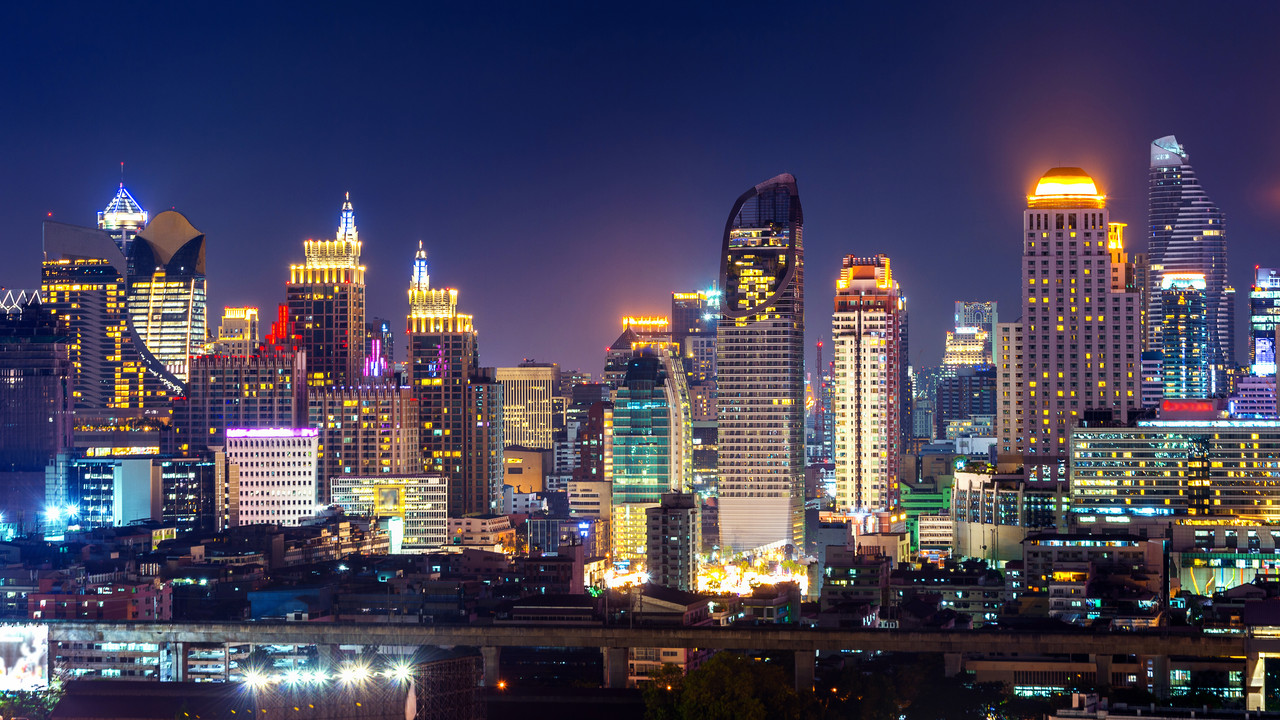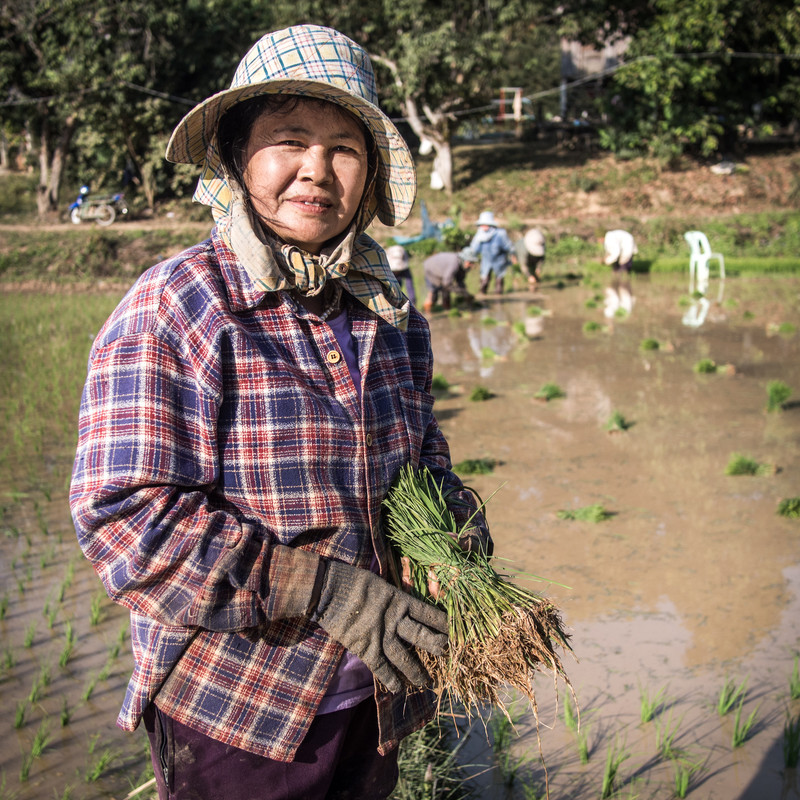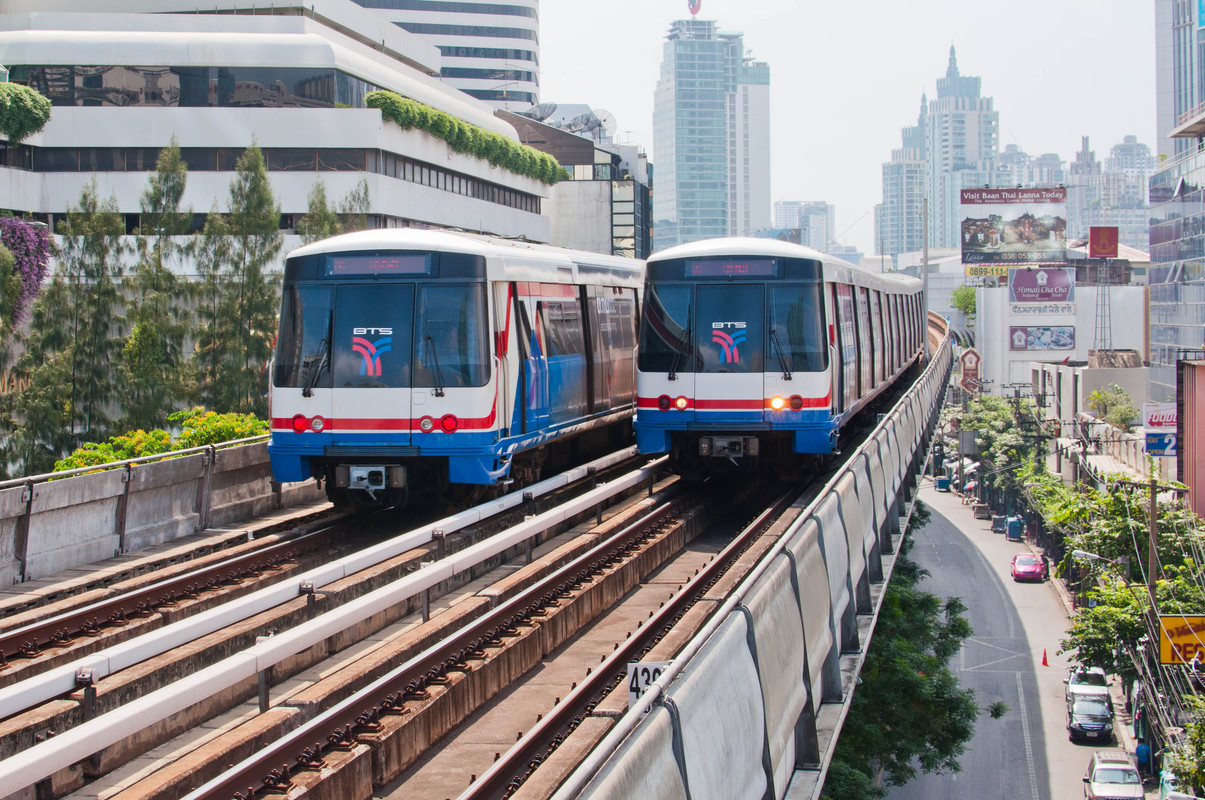- May 4, 2021
- 2,411
The Encyclopedia of Thailand is an ESSENTIAL roleplay resource for any roleplayers to interact with Thailand in MN. This alternative country has been undertaking a continuous world-building and complete overhaul of almost all systems in Thailand. It is generally unreliable to research Thailand in real life and then use it as if it is Thailand in MN.
FAQs:
1. Do you write all of these yourself?
Ans: Yes and No. The entire original text, currently more than 25,000 words, is entirely written by me. However, all these texts are then processed into a natural language processing model to refine the tone of the context to be more encyclopedias, for better or worse.
2. Is this encyclopedia public knowledge in MN?
Ans: Absolutely. There had been a mention of an MN Wikipedia page of Thailand being available.
3. How much validity and reliability of this encyclopedia are?
Ans: Virtually valid and reliable. All information within this encyclopedia is considered canorn and is written from a neutral perspective as much as possible. What is mentioned or documented in this encyclopedia can be trusted as what represents MN Thailand.
4. How can I trust since it is available in MN Wikipedia? Is there any Character reason?
Ans: MN Thailand is a highly transparent nation with many roleplayed legislations. Most information is already public knowledge and it is generally true when people in MN Thailand always scrutinize its government.
FAQs:
1. Do you write all of these yourself?
Ans: Yes and No. The entire original text, currently more than 25,000 words, is entirely written by me. However, all these texts are then processed into a natural language processing model to refine the tone of the context to be more encyclopedias, for better or worse.
2. Is this encyclopedia public knowledge in MN?
Ans: Absolutely. There had been a mention of an MN Wikipedia page of Thailand being available.
3. How much validity and reliability of this encyclopedia are?
Ans: Virtually valid and reliable. All information within this encyclopedia is considered canorn and is written from a neutral perspective as much as possible. What is mentioned or documented in this encyclopedia can be trusted as what represents MN Thailand.
4. How can I trust since it is available in MN Wikipedia? Is there any Character reason?
Ans: MN Thailand is a highly transparent nation with many roleplayed legislations. Most information is already public knowledge and it is generally true when people in MN Thailand always scrutinize its government.
Friday April 19, 2024 | 15:00 UTC+7
- Added the intial entry on the values and beliefs section under the Culture and Society sector.
- Finalized the Bhumjaithai Merging Into the Democrat section under the 2003-Present: Era of Progressiveness sector.
- Added the 2004 Thai Provincial Election section under the 2003-Present: Era of Progressiveness sector
- Added Bhumjaithai Merging Into the Democrat section under the 2003-Present: Era of Progressiveness sector.
- Added the initial entry of the Bhumjaithai Merging Into the Democrat section under the 2003-Present: Era of Progressiveness sector.
- Added README text
- Added What's New text
- Added entry on the E-Commerce Logistic Hubs under the Transportation sector.
- Updated the number of AN/TPS-77 which Thailand operates from 5 to 8 under the Military Capability sector.
- Fixed misplaced entry of the Republic Navy section under the Military Capability sector by replacing it with a rudimentary entry.
◤Republic of Thailand
The Republic of Thailand (Thai: สาธารณรัฐไทย, RTGS: Satharana-rat Thai), historically known as the Kingdom of Thailand and Siam, is a sovereign state in Southeast Asia and one of the three dominant world powers alongside the United States and the United Kingdom. In 1998 following the end of its monarchical era, the country established itself as a republic in April of the same year. Thailand is a country in Southeast Asia on the Indochinese Peninsula. With a population of over 71 million, it spans 513,120 square kilometres (198,120 sq mi). Thailand is bordered to the northwest by Myanmar, to the northeast by Laos, to the southeast by Cambodia, to the south by the Gulf of Thailand and Malaysia, and to the southwest by the Andaman Sea; it also shares maritime borders with Vietnam to the southeast, and Indonesia and India to the southwest. Bangkok is the nation's capital and largest city.
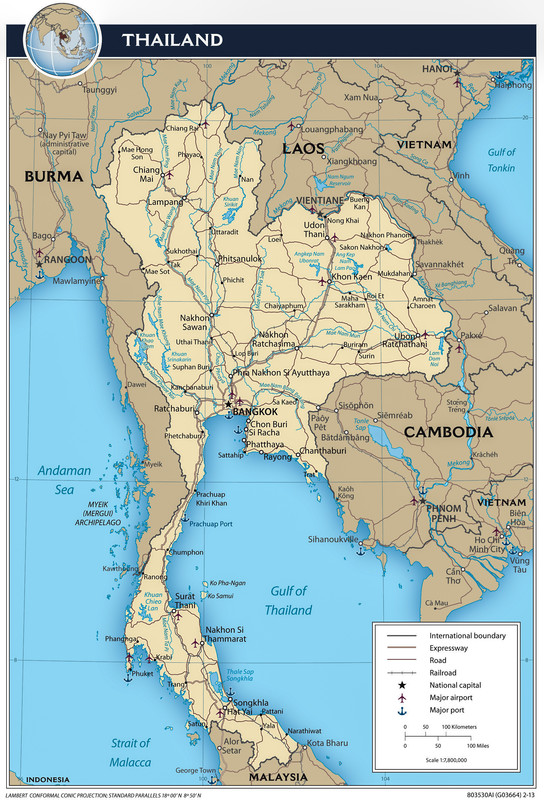
Map of Thailand
◤History of the Republic of Thailand
◤Pre-1998: Kingdom of Thailand
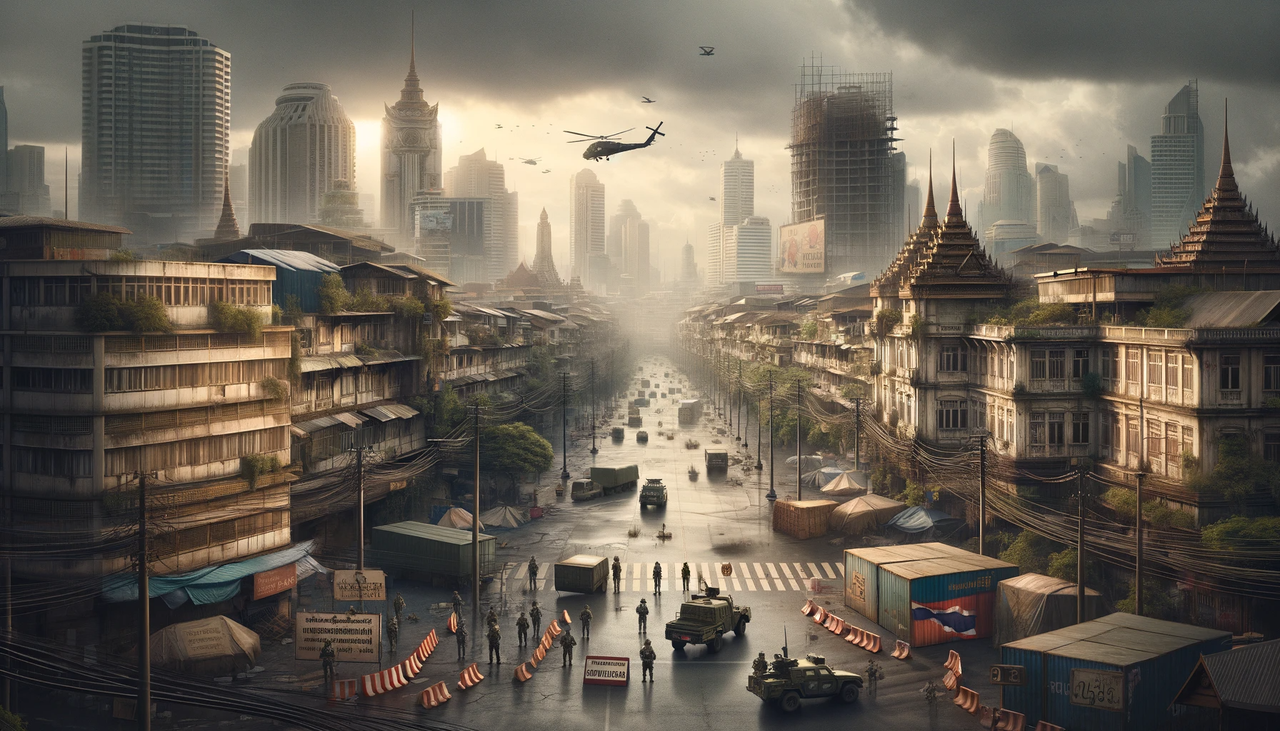
Bangkok in 1995
In 1995, following the dissolution of the United Nations, Thailand, along with several other nations, experienced a period of isolation due to the destabilization of the global order. This era saw a shift in Thailand's political structure under Rama IX of the Chakri Dynasty, representing the Rattanakosin Kingdom, who assumed a more centralized form of governance. This development was a notable deviation from the country's previous governmental system.
During this time, Thailand became involved in regional conflicts, particularly in the context of the Third Indochina War. The country's military actions, referred to as the Rattanakosin Invasion, involved operations in neighboring Laos and Cambodia, beginning in late 1996. By early 1997, these military engagements led to the annexation of Laos and Cambodia, significantly altering the political dynamics of the region. However, this period of expansion was marked by challenges.
The annexation phase witnessed internal unrest in Thailand, including failed military coups and political instability. The culmination of these internal issues led to the dissolution of the monarchy, triggered by an uprising following an informal and unsanctioned referendum. The momentum for change was further amplified by the Declarations of Independence by Laos and Cambodia in late 1997. These events marked the end of Thailand's brief return to a more centralized form of governance and its territorial expansion, signifying a pivotal moment in the nation's political history. This era had profound effects on the regional landscape of Southeast Asia and had lasting implications for Thailand's domestic politics and governance structure.
◤1998-2003: Rise to Power
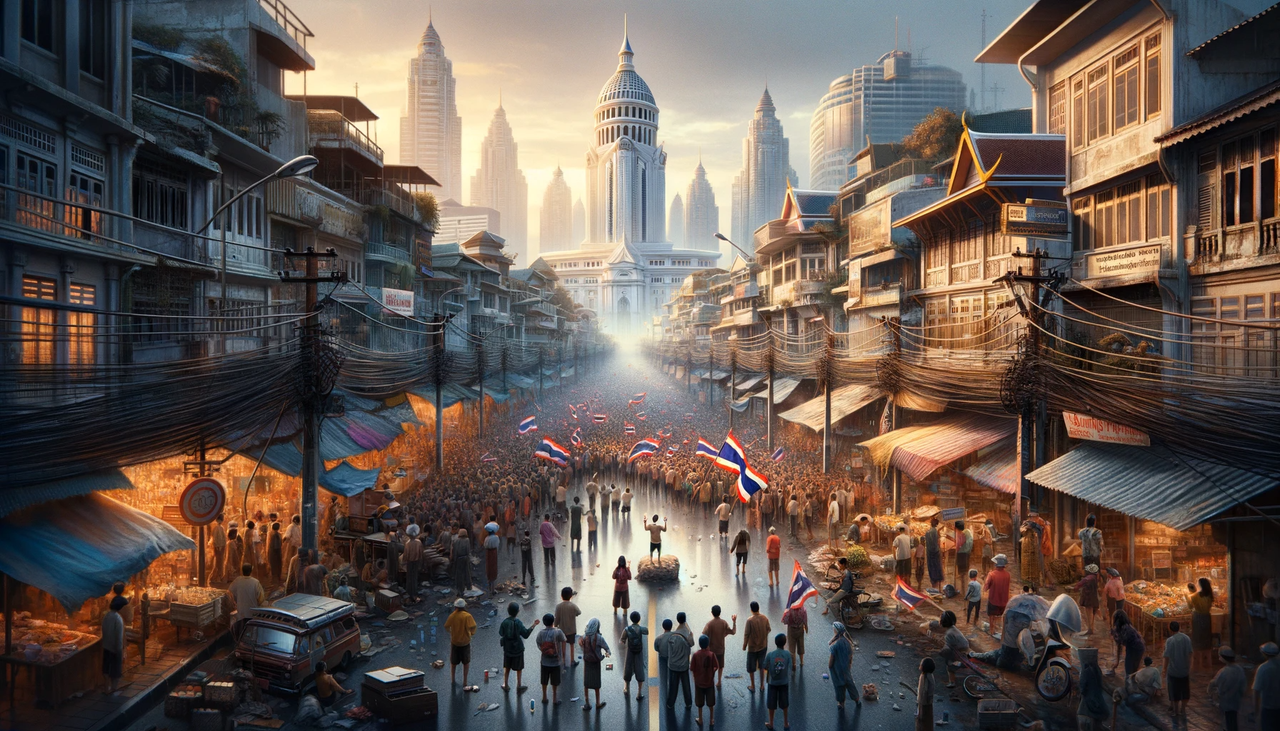
The Thai 1998 Revolution
◤Thai 1998 Revolution and Identity Crisis
In 1995, Thailand faced a period of political instability and a breakdown of the existing world order, leading to a power vacuum. Amidst this uncertainty, a pivotal national referendum was conducted on January 15, 1998. This referendum, largely driven by members of the Democrat Party, was designed to reassess and redefine Thailand's national identity in light of the changing global circumstances. At the time, Thailand was confronting economic difficulties, declining living standards, and setbacks in social progress, fueling a widespread demand for change.
The outcome of the 1998 Thai Referendum revealed a predominant preference among the population for the formation of a republic, with the Democrat Party proposed to lead. Following this outcome, the Constitution of the Republic of Thailand was drafted and finalized in April1998. Concurrently, the first Government of the Republic of Thailand was established, signifying a major shift in the country's political structure.
One of the initial key priorities of the new Republic was to reestablish international relationships and concentrate on domestic infrastructure development. This era was characterized by continuous amendments to the constitution, reflecting the ongoing uncertainty and the evolving identity crisis within the Thai population, including government officials. There was a collective endeavor to redefine the concept of the Thai nation in the face of a radically transformed global and internal political context. This period in Thai history is particularly significant for its efforts in forging a new national identity and the complexities involved in adapting to a post-world order environment.
◤Swedish-South African War and "Enlightened Mission"
In late 1998, coinciding with the Swedish-South African War, the Thai Government undertook a humanitarian mission to South Africa, aligning itself with Sweden's global leadership. This mission was a significant representation of Thailand's commitment to international humanitarian efforts.
During a six-month operation, Thai government and military personnel played a crucial role in providing aid in South Africa. This mission resulted in the successful assistance and rescue of over two hundred thousand South African citizens. This operation, referred to as the "Enlightened Mission," garnered wide recognition and praise for its impact and effectiveness. The mission not only underscored Thailand's ability in international humanitarian assistance but also deeply influenced the Thai population, fostering a strong commitment to aiding those in need.
The "Enlightened Mission" is considered a defining event in the evolution of Thailand's contemporary values and foreign policy. The success and influence of this humanitarian mission are seen as having shaped Thailand's focus on human rights within its national ethos. This mission is often highlighted as a contributing factor to the prominence of human rights considerations in Thailand's moral and policy frameworks.
This period in Thai history underscores the country's dedication to humanitarian principles and its active role in international relief efforts. Thailand's response to the crisis in South Africa during the Swedish-South African War exemplifies the potential for a nation to make a significant contribution to global humanitarian causes, reflecting Thailand's commitment to upholding human rights and extending aid beyond its borders.
◤Pattani Insurgency and the Parliament Dissolution
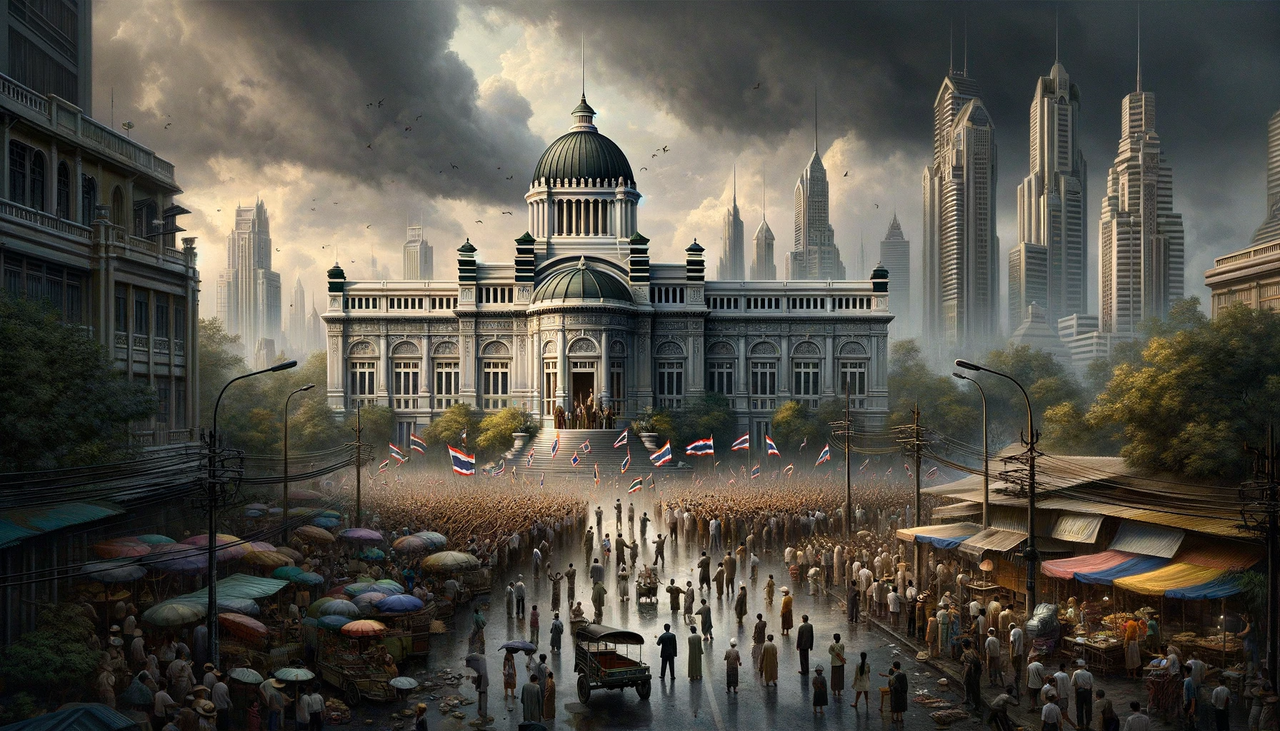
The protest in front of a Thai Government building before
the dissolution of the first Republic of Thailand Parliament
During a critical phase in the Republic of Thailand's history, the government of Chuan Leekpai faced accusations from the Opposition of financial misconduct related to the Enlightened Mission. It was alleged that the government had received monetary compensation from Sweden significantly exceeding the mission's actual cost. This accusation sparked widespread public discontent, as it was perceived that the government had exploited a situation involving people in need, an action considered unacceptable by the general population.
Simultaneously, Thailand faced internal political tensions that threatened to escalate into civil conflict. Monarchist factions, advocating for the restoration of the monarchy, formed various rebel groups across the country. Notably, the former Thai monarch was reportedly compelled to endorse these groups as his official force, aiming to re-establish the monarchy.
The situation was further complicated by external involvement, particularly from the Congolese Empire, which allegedly supported the monarchist movement in Thailand. Congo, noted for its military capabilities, was reportedly a primary supplier of military aid to the Thai rebels. The conflict escalated to a significant degree, with reports of a severe attack on Don Muang Airport, allegedly involving advanced military assets such as a nuclear submarine or ICBM, from the Congolese forces. This attack was beyond Thailand's defensive capabilities and reportedly fueled the momentum of the rebel movements.
In response to the rising insurrection, the Thai Air Force undertook substantial bombing operations in Pattani province. While these actions were aimed at quelling the rebellion, they also led to increased public disapproval of the Chuan Administration due to the severity of the military response.
The culmination of these events was a successful no-confidence vote against the Chuan administration, leading to its resignation. This paved the way for the first general election in Thailand's republic era, marking a significant turning point in the nation's political landscape.
◤Thaksin First Cabinet

Bangkok in 1998 after the end of the 1995 Recession
In August 1998, following the dissolution of the parliament, the Thai Rak Thai Party, led by Thaksin Shinawatra, a former business magnate who had divested his assets to enter politics, emerged victorious in the elections, securing the majority of seats in the Thai Parliament. The party's rise to prominence was facilitated by its comprehensive manifesto, which resonated with the Thai populace, then grappling with the nation's identity. The Thai Rak Thai Party's campaign effectively positioned Thailand as a stable platform for its citizens.
The first Thaksin Administration was established in late April as a coalition government. The initial 90 days of this administration were marked by a concentrated effort on constitutional revisions and legislative drafting, with the Thai Parliament engaging in daily debates and voting on numerous legislative matters.
During this period, 36 pieces of legislation were passed, and the Constitution underwent 15 revisions. Following these legislative achievements, the Thaksin Administration initiated significant investments in foundational infrastructure, allocating approximately $24 billion in this sector, one of the largest investments globally since 1995.
A substantial portion of this budget, around $20 billion, was allocated to the Bangkok Metropolitan Area Mass Rapid Transit System Master Plan, initiated in late 1999. This project, conceived as a mega infrastructure endeavor, was scheduled for completion towards the end of the administration's term. Today, the Bangkok Mass Rapid Transit (MRT) system is recognized as one of the busiest and most advanced in the world, with daily ridership figures of 11.2 million and an annual ridership of approximately 4.088 billion.kok MRT system today stands as the busiest and most advanced system in the world. It has a daily passenger of 11.2 million and annual raiders of 4.088 billion.
◤Military Shadow Government and the Fourth Indochina War
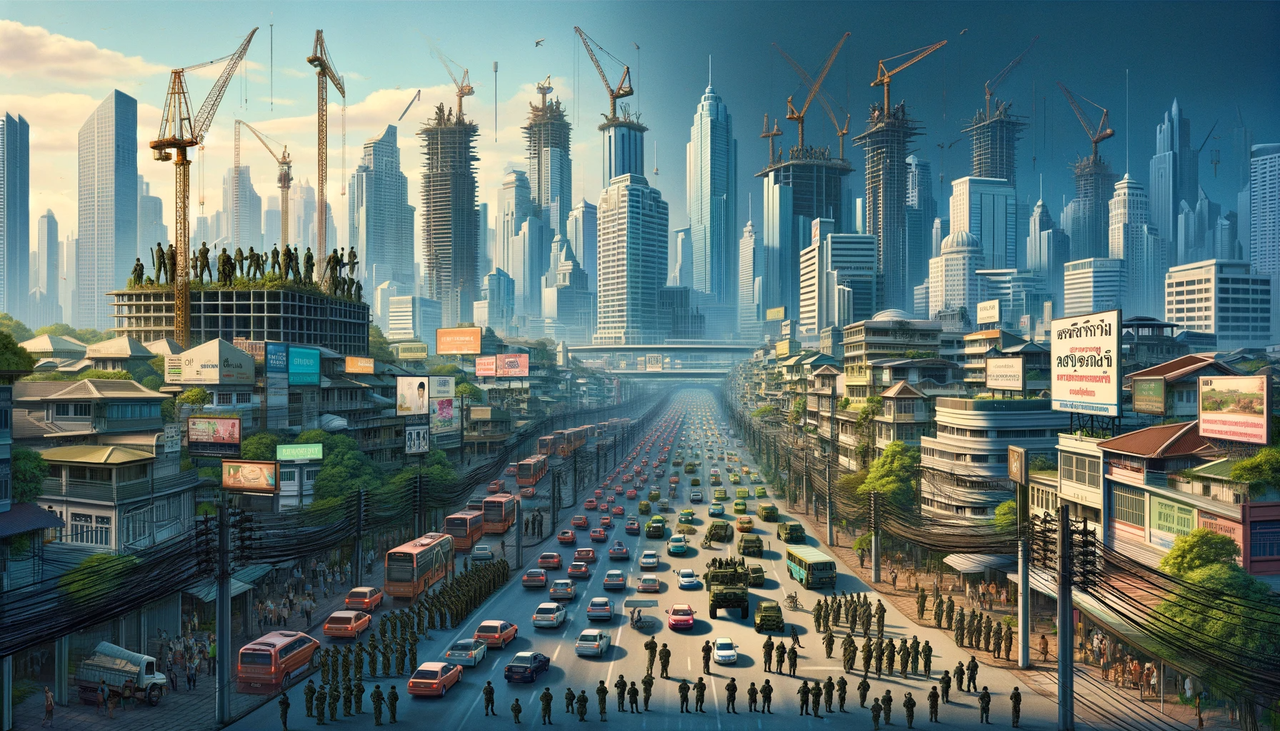
Economic Boom in 2002 Bangkok under the shadow government of the military
From 2000 to mid-2001, Thailand underwent a period of rapid military modernization and expansion. During this time, the military's influence within the government increased, leading to the re-establishment of the National Intelligence Agency (NIA) by Prime Minister Thaksin Shinawatra. The NIA was placed under his direct command, signifying a consolidation of intelligence operations within the government.
In mid-2000, a significant event occurred involving high-ranking military officers and special forces at the Government House. A negotiation took place, which ultimately led to the military establishing a form of 'Shadow Government' over the Thaksin administration. This development was indicative of the growing influence and assertiveness of the military in Thai politics.
A critical outcome of these negotiations was the decision to invade Laos and Cambodia later in 2000. This military expansion marked the onset of the Fourth Indochina War, leading to prolonged regional instability.
The initial phase of the invasion targeted Laos. However, during this conflict, the NIA operated covertly to undermine the efforts of certain Thai military officers. This intervention by the NIA contributed to the eventual peace treaty between Thailand and Laos.
As the year progressed, Thaksin Shinawatra began to regain control over his government. Faced with diminishing influence, the military then engaged in a territorial dispute with Cambodia. This conflict culminated in a significant purge of high-ranking Thai military officers, leading to a return to the pre-conflict status quo in the region by mid-2001. This period in Thai history is notable for its complex interplay between military expansion, intelligence operations, and shifting political dynamics.
◤Rise of Strategic Rivalry and Multi-polar World
In 2002, seven years after the dissolution of the United Nations and the collapse of the previous world order, Thailand experienced significant developments in power, infrastructure, technology, and welfare. The early investments of the Thaksin Administration had bolstered the country's foundational infrastructure, positioning it to better serve its population. With its nation-building phase nearing completion, Thailand shifted its focus to proactive and innovative diplomatic efforts.
During this period, the global political landscape was predominantly influenced by four nations: the United States, the United Kingdom, Thailand, and Sweden, with the latter showing a decline in its global role.
Despite the challenges associated with its transition to a republic, Thailand emerged as a notably stable and resilient nation in Asia. In the absence of other active players on the continent, Thailand became a leading representative of Asia on the world stage.
Thailand's international relations during this time included a notable partnership with the United Kingdom, exemplified by a Student Exchange Program. However, this relationship experienced changes following the British elections in 2003.
A significant aspect of 2002 was the emerging, albeit indirect, rivalry between Thailand and the United States. This period witnessed occasional military standoffs between their navies, contributing to heightened tensions. These incidents prompted Thailand to further enhance and modernize its naval capabilities, aiming to match the naval strength of the United States.
◤The Bangkok incident
In late 2002, towards the end of the first term of Prime Minister Thaksin Shinawatra’s administration in Thailand, a significant and unfortunate event occurred: the bombing of the US, UK, and Polish embassies in Bangkok. This act of terrorism was attributed to the Thai National Stability Party, a radical group whose leading figures had previously evaded military purges and were connected to the Pattani Bombing.
The bombings had far-reaching and detrimental impacts on Thailand's international relations, particularly with the countries whose embassies were targeted. In response to the attacks, both the United States and the United Kingdom made the decision to close their diplomatic missions in Thailand, signifying a severe breakdown in diplomatic relations. Additionally, the incident complicated Thailand's relationship with Poland, exacerbating cultural misunderstandings and straining diplomatic ties.
Despite subsequent investigations by Thai authorities, which led to the detention of all individuals involved in the embassy bombings, relations between Thailand and the Western nations affected have remained strained. The US and the UK continued to maintain a stance of indifference towards Thailand even after the resolution of the incident.
This event marked a critical turning point in global geopolitics, signifying the beginning of increased polarization between Eastern and Western nations. The embassy bombings in Bangkok not only had immediate consequences in terms of diplomatic relations but also contributed to a broader shift in international dynamics, highlighting the profound impact that such acts of terrorism can have on global political landscapes. The incident remains a pivotal moment in Thailand’s recent history, underscoring the challenges of navigating complex international relations in the face of extremist violence.
◤2003-Present: Era of Progressiveness
◤Thaksin Second Cabinet First 30-Day Success
The year 2003 was a period of significant developments in Thailand, marked by notable political, economic, and infrastructural milestones. In January 2003, Thailand achieved a major infrastructural milestone with the completion of the Bangkok Metropolitan Area Mass Rapid Transit System Master Plan. This plan laid the groundwork for the expansion and enhancement of Bangkok's mass transit system, aiming to improve transportation efficiency and connectivity in the capital city. February witnessed a landmark political event when the Thai Rak Thai Party, led by Thaksin Shinawatra, secured a historic victory in the national elections. The party won 420 out of 500 seats, enabling it to form the first single-party government in Thai history. This election result was significant as it represented the first-ever landslide victory in Thai electoral politics. In March, the Thai Government, under the newly formed administration, passed the Economic Diversification Bill. This legislation aimed to broaden Thailand's economic base and reduce dependency on any single economic sector. Within just a month of taking office, the government committed over $20 billion to various infrastructure projects throughout the country. These projects were designed to spur economic growth and development across various regions.
Before the end of 2003, the Thai Government announced plans to invest an additional $22 billion in five regional projects and two mega projects. This ambitious investment plan was part of Thailand's broader strategy to enhance its infrastructure and promote balanced regional development. Furthermore, the Thai Government provided an update on the country's progress towards its 2005 Sustainability Goals, which were set back in 1999. They announced that Thailand was on track to achieve these goals and become a sustainably self-reliant country by 2005. This announcement underscored the government's commitment to sustainable development and its efforts to position Thailand as a leader in this area. Overall, the events of 2003 reflected significant strides in Thailand's political, economic, and infrastructural development, showcasing the government's commitment to long-term strategic planning and sustainable growth.
◤The First 90-Days Foreign Policy Failure
The initial 90 days of Prime Minister Thaksin Shinawatra's second cabinet in Thailand were marked by a series of significant diplomatic efforts and challenges. This period saw a mix of ambitious initiatives and complex international interactions. One of the key objectives of Thaksin's administration during this period was to establish the Asian Unity Council, aimed at fostering closer cooperation among Asian nations. However, this initiative did not gain the anticipated interest or support from other Asian countries. The proposal for the Council was met with a lack of enthusiasm, failing to generate enough interest to bring the idea to fruition. Furthermore, the Thai government's attempts to engage in the Israeli-Palestinian crisis did not yield positive results. Instead, the situation reportedly worsened following Thailand's intervention. The complexities of the crisis, coupled with Thailand's limited experience in mediating such longstanding and intricate international conflicts, contributed to this outcome.
In a particularly notable incident, the Thai government was involved in a diplomatic conflict following the execution of an Egyptian Chief of Foreign Affairs by the National Intelligence Agency (NIA) of Thailand. This execution was reportedly in response to an attempted assassination of the Thai Prime Minister. This incident led to heightened tensions and drew international attention to Thailand's foreign policy and security measures. These developments during the first three months of Thaksin's second term highlighted the challenges Thailand faced on the international stage. The mixed results of these diplomatic efforts underscored the complexities of global politics and the difficulties in navigating them, especially for a country like Thailand, which was striving to assert its role in international affairs. Consequently, these events contributed to a more polarized global environment, where many nations sought to assert strategic independence from more influential countries.
◤The Thai Airways International Flight TG409 Incident
In a significant move to enhance military oversight, the Thai parliament passed the Military Modernization Bill. This legislation aimed to maintain stringent checks on the military, with the National Intelligence Agency (NIA) playing a key role in monitoring. Concurrent with this legislative development, the bill facilitated the allocation of resources for military procurement, signaling a commitment to modernizing Thailand's military capabilities.
Amidst these developments, on April 5, 2003, Thailand experienced a major aviation disaster when a Thai airliner encountered a severe weather phenomenon known as a Hypercell. This encounter led to a catastrophic crash in the Gulf of Thailand, resulting in significant loss of life and aircraft destruction.
In response to this tragedy, the Thai military initiated Operation People Resolve, a large-scale search and rescue (SAR) mission. The operation mobilized 5,295 personnel, drawing significantly from the Naval Special Warfare Command and the Air Force, with the majority being from the Navy. This deployment demonstrated the readiness and capability of Thailand's military in responding to national emergencies.
The effectiveness of Operation People Resolve was notable. The Thai military, with substantial support from the Navy, achieved remarkable success in the mission. Within the first 72 hours of the operation, all debris from the crash, human remains, and aircraft structures were successfully recovered. This swift and efficient response highlighted the proficiency and preparedness of Thailand's military forces in dealing with high-stakes emergency situations.
These events – the passage of the Military Modernization Bill and the response to the aviation disaster – collectively underscored the evolving nature of Thailand's military and its crucial role in both national security and emergency response. The successful SAR operation following the airline crash particularly demonstrated the military's operational effectiveness and readiness to handle complex and urgent situations.
With the help of a sizeable portion of the Navy, the Thai military was strikingly successful in recovering all debris, human remains and aircraft structures within the first 72 hours.
◤The Myanmar Question
During the second quarter of 2002, the Myanmar military government, the State Peace and Development Council, launched an air attack and fire execution on ethically minority populations. The atrocities in Myanmar had been faced with a strong condemnation by the Thai Government. The repercussions of the ethical cleansing have led to the largest refugee crisis since the Vietnam War with 2.5 million asylum seekers crossing the border into Thailand.
The Myanmar refugee crisis has led to regional instability and an economic burden on Thailand. The country already housed over 1.5 million migrant workers from Myanmar, all of whom receive benefits from the Welfare State, and the additional 2.5 million refugees had strained Thai resources.
On April 5th, 2003, five Thai soldiers from the 2nd Long Range Reconnaissance Company of the 2nd Infantry Division illegally crossed the Thai Myanmar border into the Kayah state. They had been accused by the Myanmar military government that they had claimed to be working under the Thai Government for an intelligence operation to ignite the uprising in Myanmar.
The incident has led to heightened tension between the two countries. Myanmar closed its border and placed 12,000 soldiers at the Thai border, which was on the same day that the diplomatic breakdown between the two countries happened. On the same day, the Thai Prime Minister, Thaksin Shinawatra, addressed the nation on the Myanmar Question which has been the hotly debated topic in the Thai mainstream media since 2002. The address announced that Thailand would be moving from patient diplomacy to an assertive one after meeting with an impasse on diplomatic solutions.
On the same day, the Thai Navy deployed its largest Naval deployment since its modernization finished in 2001. The Naval Expeditionary Group One (NEG1) was deployed to the Andaman Sea, which was the second time that they deployed an entire asset after the Thai International Airways Flight TG409 Incident. Within a week of escalation, over 700,000 Thai and Burmese troops combined were stationed at the Thai Myanmar border.
As both nations were on the brinkmanship, public outrage in Thailand happened as they called for a national referendum during the Anti-War Protest in Bangkok. Over 39 million out of 41 million Thai people registered to vote in favor of the de-escalation and demobilization. The Myanmar Question began to disappear from the mainstream media as the Thai Government adopted proactive diplomacy toward Myanmar's transition into a democratic state.
◤Commitment to Regional and National interests
On April 4th, 2003, the Thai Navy launched Operation Seafaring I as a ceremonial deployment of the newly established Naval Expeditionary Groups Two (NEG2) and Three (NEG3). Although the main disclosed detail of such an operation was to have each NEG swap their base in the Gulf of Thailand and the Andaman Sea, the actual operational history had proven otherwise. With approximately 30 warships deployed, both NEG2 sailed past each other on April 5, 2003, in the Malacca Strait, just outside of Singapore City. A few speculation and conspiracy theories were formed, but due to the Thai national law on the collective defense of the Southeast Asian nations, every demonstration and "show" was arranged beforehand with the governments of Singapore, Indonesia, and Malaysia.
On April 7, 2003, in the late evening, NEG2 was spotted passing through the Malacca Strait another time. At the same time, NEG3 also departed from the Songkhla Naval Base. On April 10th, 2003, both NEG2 and NEG3 sailed through the Taiwan Strait, marking the first naval show of force since the Second Taiwan Strait Crisis. Regardless the claims made by the media, the Republic Thai Navy spokesperson reaffirmed that Operation Seafaring I was purely ceremonial and referred to their motto: Join the Navy to see the world.
On May 10th, 2003, the Thai Navy launched Operation Guardian Harmony patrolling mission of Southeast Asia. The operation was described as the "commitment to Southeast Asia's Security and Stability Act, B.E. 2546," which positioned Thailand, internally through national law, as the security and stability guarantor of the region. While the exact number published by the Thai Defense Ministry revealed that 2,869 is already deployed at sea, experts and scholars in regional politics speculate that at least ten thousand personnel are standby to be always deployed-ready. The sighting and comprehensive report of intelligence gathered of at least 9 Polish Navy vessels passing through the Timor Sea by HTMS Loe Thai suggested that the Thai navy has the capacity to cover the entirety of Southeast Asian water as they claim.
Furthermore, the operation also included the deployment of a Thai helicopter carrier, HTMS Sukhothai Narubet, carrying 24 EC725 Caracal to conduct anti-piracy operations, Search and Rescue (SAR) missions, casualty evacuation procedures, law enforcement activities, Humanitarian Assistance/Disaster Response (HADR), and Maritime Surveillance and Intelligence Gathering (MSIG). In parallel with other 27 Republic Thai Coast Guard vessels, the carrier itself also conducted frequent drill and exercise during their time at sea. It had been reported, based on the financial document of Operation Guardian Harmony, that all warships were armed, gone through a rigorous maintenance, and in a state of "ready to engage to any threat to the regional peace, stability, security, and democracy immediate."
On May 29th, 2003, the Thai Prime Minister, Thaksin Shinawatra, made a national address after three weeks of his absence on screen. The transcript of the address was named "The Prime Minister's Address on the Year 2004 to 2007 Outlook for Thailand." The content started with Thaksin recounting the early success of Thailand in 2003 as being "remarkably distinguishable" for the Thai people and the nation has been "particularly extraordinary." He boasted about the success of the world largest MRT project ever constructed by date, the "Mass Rapid Transit Master Plan in Bangkok Metropolitan Region," which was invested by the Thai Government back in late 2001, making it to be the busiest MRT in the world. The volume of $20 billion, or 705.8 billion Thai Bath, in a single project was accounted to be 80% of government planned investment fund for the Economic Diversification Bill during mid-2003 to early-2004. While the government, especially Thaksin himself, claim it to be the success of all Thai people, the Opposition Party argues that it was a contradictory that the ruling party to be "so advocated for the diversified, self-reliant Thai Economy, yet the first mega project was focused on the already wealthy Greater Bangkok."
In the same address, the Thaksin announced that Thailand will be taking an initiative-taking diplomacy, describing it as "foreign affair tangible by the Thai people." The interpretation of this statement is varying, but most experts agreed and concluded that Thailand will focus on a policy that directly benefits the citizens, linking foreign engagements back to domestic welfare. This statement has been solidified by the first success of the Thaksin Second Cabinet's foreign policy after more than four months in power. Thaksin mentioned the successful implementation of the Harmonious Accord signed by Minister of Foreign Affair of the Empire of France and the President of the Republic of Türkiye. While each document was signed separately with Thailand as a mutual partner and the treaty was tailored to each country, both France and Turkey, while differed in religious stance, shared common positive relationship and "strategic official alliance" with Thailand. At the same time, it was revealed that Thailand had established a high-level negotiation to expand the signatories of the Harmonious Accord with Spain, Portugal, Poland, Australia, and Japan.
◤Espionage on Poland
On June 1st, 2003, a significant diplomatic incident occurred between Thailand and Poland, with far-reaching implications for international relations. The Polish Government publicly accused Thailand of conducting espionage activities against Poland, a charge that rapidly escalated tensions between the two nations. Central to this controversy was the alleged involvement of the Tatvan/Bitlis Long Range Reconnaissance Company, a unit of the Republic Thai Army's Middle East Command. This unit was accused of being directly implicated in the unauthorized dissemination of sensitive information. The leaked data included high-resolution images and a five-minute video depicting activities around Israeli territorial waters, with the involvement of both Polish and Israeli forces.
Further complicating the issue, the documents purportedly revealed communication between the Thai and Polish governments, suggesting that the Polish operation was an intelligence-gathering exercise with a focus on Israel. This disclosure raised significant international concern regarding the objectives and legality of Thailand's military operations outside its borders, particularly in the context of global diplomatic norms and espionage laws.
The incident took a more serious turn when the Polish Government alleged the capture of five Thai nationals on espionage charges within Poland. According to Polish authorities, these individuals were implicated in over 200 instances of activities classified as malicious. This claim intensified the diplomatic crisis, marking a severe escalation in the conflict between Thailand and Poland. In a decisive response to the allegations and the supposed evidence of espionage, the Polish Foreign Ministry initiated the extraordinary measure of closing the Thai embassy in Poland. This closure signified a severe breakdown in Thai-Polish diplomatic relations and was a direct consequence of the espionage allegations.
On June 2nd, 2003, a significant development occurred in the diplomatic incident between Thailand and Poland. The Ministry of Justice of Thailand, in conjunction with a collective of 2 million signatories, dispatched an open letter to the Polish Government. This letter was a response to the detention of Thai citizens in Poland on charges of espionage, as previously reported.
In the letter, the Ministry of Justice of Thailand extensively referenced the Universal Declaration of Human Rights. The primary focus of the letter was to demand the Polish Government ensure that the detained Thai citizens receive impartial and humane treatment. This appeal highlighted concerns regarding the legal and human rights aspects of the detainees' treatment under Polish custody.
However, the Polish Government's response to this appeal was to reject the demands outlined in the letter. The Polish authorities asserted that, as a member of the Global Assembly, they were not obligated to adhere to the Universal Declaration of Human Rights in this matter. This stance by Poland indicated a divergence in the interpretation and application of international human rights norms, particularly in the context of the Global Assembly's framework.
◤Exercise Naga Trident 2003
From June 10th to 20th, 2003, the Thai Navy embarked on an extensive naval exercise known as Exercise Naga Trident 2003. This event occurred amidst a period of reduced international focus on Thailand following the allegations of espionage in Poland earlier in the month. Exercise Naga Trident 2003 holds a distinctive place in regional military history, being recognized as the largest naval exercise ever carried out in Southeast Asia.
Remarkably, Thailand was the sole participant in Exercise Naga Trident 2003, yet the magnitude and complexity of the operation were unprecedented. The exercise involved a significant commitment of resources and personnel, with a total of 34,603 Thai military personnel actively participating in the ten-day drill. This extensive involvement underscores the Thai Navy's capacity for large-scale operations.
In terms of naval assets, the exercise saw the deployment of 72 commissioned vessels from the Republic Thai Navy. This fleet composition highlighted the Thai Navy's operational capabilities and its readiness to execute complex maritime maneuvers and strategies.
While the primary aim of Exercise Naga Trident 2003 was to test and enhance the operational readiness of Thailand's naval forces, some experts in international relations viewed the exercise through a geopolitical lens. They posited that the exercise also served a strategic purpose as a show of strength and deterrence, particularly to the United States. This perspective stems from the belief that the exercise was, in part, a response to the souring relationship between Thailand and the United States over the years. The conduct of such a large-scale exercise by Thailand alone, without international partners, was seen as a demonstration of its self-reliance and military prowess in the region.
◤Reapprochement
In early August, the Government of Thailand issued an official gazette announcing the restoration of diplomatic relations between the United States of America and the Republic of Thailand. This development followed a period of diplomatic tensions. High-level discussions involving the Prime Minister of Thailand, Thaksin Shinawatra, and the President of the United States, Al Gore, culminated in a successful dialogue concerning the bilateral relations between the two nations. The renewal of the Thai-U.S. relationship was symbolized by the reopening of Thai embassies and consulates in the United States. Concurrently, due to ongoing security concerns, the Canadian embassy in Bangkok temporarily facilitated the American diplomatic mission. This arrangement was put in place as an interim measure until the security issues were adequately addressed, ensuring a safe environment for the reestablishment of the U.S. embassy in Bangkok.
On September 5, 2003, the Thai Embassy in Warsaw, Poland, officially resumed its diplomatic mission, marking the end of a period of diplomatic estrangement between Thailand and Poland. Reports from official sources indicate that the Prime Minister of Thailand and the King of Poland, who were believed to share a cordial relationship, engaged in a direct video conference aimed at addressing and resolving issues of mutual trust that had previously strained the bilateral relations. The Thai Ministry of Foreign Affairs publicly announced the successful conclusion of these discussions, highlighting the restoration of diplomatic ties. Furthermore, it was revealed that a Polish company, previously involved in telecommunications modernization projects in Vietnam in 1999, had been selected for the task of reconstructing the Polish Embassy in Bangkok. This decision was part of the broader initiative to strengthen diplomatic and economic relations between Thailand and Poland.
◤Comprehensive Sex Education Law
On September 7, 2003, Thailand achieved a significant milestone in its educational and social policy history with the enactment of the Comprehensive Sex Education Law. The legislation, proposed by MP Kampong Tepakam of the Thai Rak Thai Party, garnered substantial support in parliament, indicating the nation's commitment to adopting progressive and pragmatic approaches in public policy.
The public response to the law was notably positive, as illustrated by a celebratory parade in Bangkok. This reaction reflects the broader context of Thai society's evolving egalitarian principles and its progressive attitudes towards issues such as same-sex marriage and the sex worker industry. These factors have contributed to a conducive environment for embracing such inclusive educational reforms.
Despite the widespread support, some segments of the population, particularly traditional and religious groups, have voiced concerns about the new curriculum. The government and educational institutions are thus tasked with addressing these apprehensions thoughtfully, aiming to facilitate the curriculum's effective implementation. The curriculum itself is designed to be adaptable, with mechanisms in place for periodic reviews and updates. This ensures its continued relevance in response to evolving societal norms, scientific advancements, and public health considerations.
The Comprehensive Sex Education Law is a significant stride in Thailand's pursuit of an educated, informed, and healthy society. It highlights the Thai Rak Thai Party's commitment to cultivating a culture that emphasizes individual rights, nondiscrimination, and well-informed decision-making in both personal and public spheres.
◤ISOC v. the Republic Thai Armed Forces
On November 15, 2003, the Internal Security Operation Command filed a comprehensive complaint with the Court of First Instance in Bangkok against the entire Republic Thai Armed Forces and all Chief of General Staff, immediately after being transferred from military oversight to the Ministry of Interior. This event tested the independence and authority of the Thai judiciary, known for its impartiality within Thailand. In response to the initial ruling against the Republic Thai Armed Forces on November 28, 2003, the military promptly appealed to the Court of Appeal in Bangkok. During the Court of Appeal proceedings, Interior Minister Wiroj Lakkhanaadisorn publicly denounced all Chief of General Staff in front of the court and the public. This incident marked a significant moment for the Thai judiciary's role in addressing internal security matters.
On December 9, 2003, the Court of Appeal held its initial hearing on the ISOC v. the Republic Thai Armed Forces case. Although the ISOC's initial complaint was comprehensive, additional information revealed by the Court of First Instance during the hearing prompted ISOC to revise their complaint for the second hearing on December 15, 2003. The first hearing remained inconclusive, requiring the court to seek more information and review the updated ISOC complaint with the Court of First Instance. In contrast, the second hearing decisively ruled against the Republic Thai Armed Forces, expressing strong disapproval. Despite this verdict, the RTARF chose to escalate the case to the highest level, obtaining writs of certiorari from the Supreme Court of Thailand. The Court, acknowledging the complexity stemming from diverse interpretations of the Constitutional of the Republic of Thailand, granted a hearing for the ISOC v. the Republic Thai Armed Forces case.
On January 2, 2024, the Supreme Court of Thailand conducted a series of hearings for the case ISOC v. Republic of Thailand Armed Forces, generating widespread debate in the country. The legal proceedings were marked by intense arguments, prompting subsequent hearings on January 5 and 8. While the first two sessions were open to the public, the third and final hearing on January 8, 2024, was held privately. The Supreme Court justified this decision by citing the potential revelation of sensitive information pertaining to national security, stability, and international standing by both ISOC and RTARF. After two days of deliberation, the Supreme Court, on January 10, 2024, announced its decision, underscoring its independence and supreme authority within Thailand. This significant ruling is seen by legal experts in Thailand as solidifying the Court's role as a crucial judicial body in the country.
In the Supreme Court's final decision, Chief of Defense Force, Supreme Commander Tampat Pongtanapat was compelled to resign and permanently prohibited from participating in any political or military activities throughout his lifetime. The Commander-in-Chiefs of the Army, Navy, and Air Force were also restricted from involvement in internal military elections. The actions against Supreme Commander Songkitti Jaggabatara stemmed from his role in the invasions of Laos and Cambodia, as well as a conspiracy to overthrow Myanmar's military government. Surayud Chulanont, holding the rank of Field Marshal, has been prohibited from continuing his military service due to actions in the Middle East that were deemed disrespectful to Thailand's ally, the Kingdom of Poland. Admiral of the Fleet Thira Hao-Charoen faces reassignment to an advisory role within the General Chief of Staff for violating the government's non-interference policy in the Western Hemisphere. Marshal of the Air Force Thananit Niumtundhi has been sentenced to life imprisonment for his unconstitutional mass bombing campaign during the Fourth Indochina War, surpassing the bombing tonnage of the Vietnam War and violating the Thai Declaration of Human Rights.
Following the Court ruling, General Songkitti Jaggabatara of the Fourth Army assumed the roles of the next Supreme Commander and Chief of Defense Forces. Independent Senator and General Yuthasak Sasiprapha became the new Field Marshal and Commander-in-Chief of the Thai Army. Admiral Kamthorn Phumhiran, a longstanding rival of former Admiral of the Fleet Thira Hao-Charoen, secured the position of Commander-in-Chief of the Thai Navy. Meanwhile, Independent Senator and Air Marshal Sukampol Suwannathat took on the role of Marshal of the Air Force and Commander-in-Chief. Subsequently, Prime Minister Thaksin Shinawatra extended an invitation to all four appointees for a dinner at the Phitsanulok Mansion, the official residence of the Prime Minister of Thailand.
◤Bhumjaithai Merging Into the Democrat
On February 14, 2004, the Bhumjaithai Party merged into the Democrat Party, with all 180 National Assembly members transferring to the latter. This event coincided with Prime Minister Thaksin Shinwatra's absence as he celebrated Valentine's Day with his wife. Democrat Party leaders and senior members held a press statement at the National Assembly alongside 180 new lawmakers. Abhisit Vejjajiva, the 39-year-old Democrat leader, declared that the merger would remove Bhumjaithai's presence from Thai politics. He stated that an agreement ensured all 180 MPs and senators aligned with his party's cause.
During the press statement, Abhisit announced that the Democrats would request a type three General Debate, which mandates the majority of the Opposition. This debate aims to clarify the foreign policy of Thailand concerning the Western Hemisphere. With the Democrat Party as the sole opposition, the request effectively passed, pending the disclosure of the date. Additionally, the 100 Democrat senators have persuaded 26 Independent senators to support the Upper House's involvement in the General Debate.
The merger between Bhumjaithai and Democrat parties stirred significant public interest, drawing crowds to a televised parliamentary session on February 19, 2004. The session marked the National Assembly's first meeting following the opposition party's consolidation. Among the attendees, approximately five thousand individuals gathered to witness this historic event in Thailand's political history.
During the session, the primary focus was on Thai foreign policy, a subject long contested between the Democrat Party and the ruling Thai Rak Thai Party. Differences in interpreting the three pillars of Thai foreign policy fueled debates, turning the session into a battleground for the opposition to push for their preferred policies. However, the ruling party's overwhelming majority often led to swift dismissal of any criticisms from the opposition.
Another point of contention was the Opposition political rhetoric regarding the ruling party to be operating under the premise of parliamentary dictatorship. They cited the overwhelming majority secured by the Thai Rak Thai since the general election and called for the check and balance to be implemented accordingly. Conversely, the MPs from the Thai Rak Thai argued that Thailand has been renowned as the beacon of democracy in Asia and the government has been actively implementing new check and balance systems.
Remaining of the session was dedicated to the debate of Thai domestic policy and situation. Given the high approval rate of the Prime Minister, the Opposition focused on the policy implementation issues on the provincial level. However, the argument from the Thai Rak Thai was that Thailand governance is built on the foundation of participatory democracy and decentralization, which they shift the blame to the incompetent of the Thai Rak Thai governor in some provinces and that their fate will be determined in the upcoming provincial election.
◤2004 Thai Provincial Election
The 2004 Thai Provincial Election was a highly anticipated event in Thailand where residents voted for their provincial governor. It took place after the Thai Rak Thai party's significant victory in the 2003 General Election. Key issues included foreign citizen naturalization, economic diversification, sustainability goals, egalitarian principles, and local development. This election recorded the highest voter turnout in Thai history, exceeding the previous record set by the 2003 General Election by 0.34 percent.
The Thai Rak Thai party won by a landslide, securing 28.6 million popular votes and capturing 40 provincial governor seats. The Democrat Party re-emerged after its defeat in the 2003 General Election, garnering 13.52 million votes and winning 20 provincial governor seats. The Green Party and Fair Party received 5.2 million and 4.68 million votes, respectively, earning 9 and 8 provincial governor seats each.
The provincial election was viewed as a gauge of public satisfaction with the Economic Diversification Act, a historic legislation unanimously passed by the lower house, as noted by the Faculty of Political Science at Chulalongkorn University. Provinces where the initial phase of implementing the Act was completed aligned with Thai Rak Thai strongholds. Conversely, provinces where the Act's first phase implementation lingered due to extended timelines leaned towards the Democrat Party, which drew support based on its economic policies from 1998.
The Green Party secured the majority of nine provincial governor seats, mainly in bordering provinces neighboring other countries. Dissatisfaction with sustainability policy implementation in Laos, Cambodia, and Myanmar fueled local voter discontent, influencing electoral outcomes. Conversely, the Fair party gained support in eight southernmost provinces by advocating for humanism, societal diversity, and addressing accountability for individuals involved in the 1998 Pattani Insurgency.
◤Government and Politics
◤Government Structure and Democratic Process
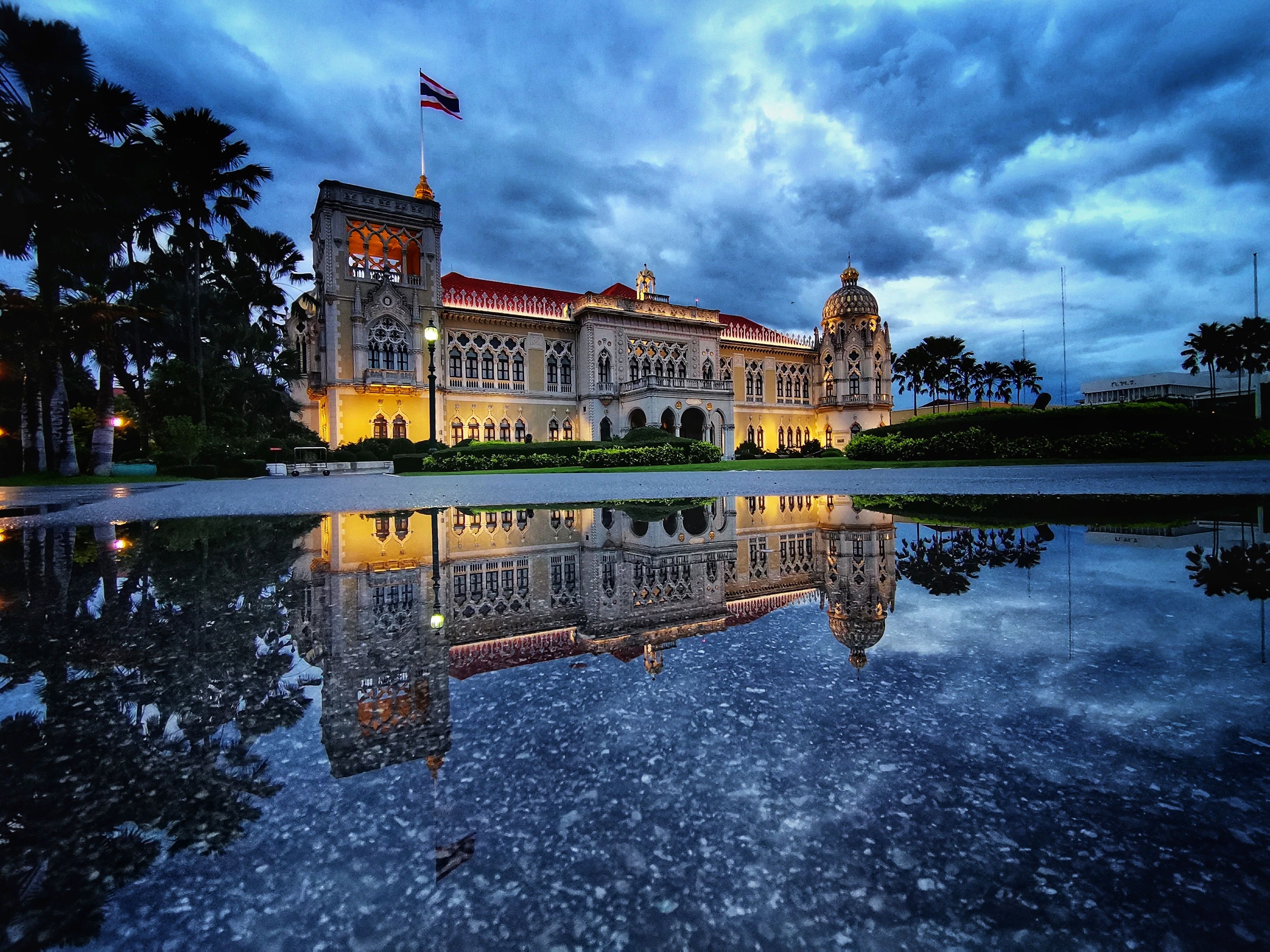
Offices of the prime minister and the cabinet of Thailand, the Government House of Thailand
Thailand's political system is emblematic of a Participatory Democracy, a model distinguished by the active engagement of its grassroots population in determining the nation's path. The governmental structure of Thailand is akin to a parliamentary system, similar in some respects to the Westminster model. However, a distinctive feature of the Thai system is the consolidation of the roles of Head of State and Head of Government in the person of the Prime Minister. This unique arrangement places the Prime Minister at the pinnacle of the executive branch, responsible for the overall direction and decision-making of the government.
The administrative responsibilities within the Thai government are distributed among five Deputy Prime Ministers, each overseeing different segments and functions of the government. This delegation of duties allows for specialized management of various governmental areas, with the Prime Minister acting as the final authority. The system effectively operates with a singular President, the Prime Minister, supported by five Deputy Prime Ministers, each with significant executive responsibilities.
Thailand's democratic process involves the election of both the leader and members of the bicameral parliament, consisting of the Lower House and the Upper House, by Thai citizens during the General Election. Members of Parliament, including the Prime Minister, serve four-year terms, with a constitutional limit of two terms per individual as Prime Minister. The Thai National Assembly comprises 500 Members of Parliament in the Lower House and 250 Senators in the Upper House. Additionally, Thailand's participatory democratic system includes 75,086 community assemblies nationwide, serving as consultative and grassroots representative bodies at the lowest administration levels.
The legislative process in Thailand involves several steps. The Lower House, the Cabinet, and a minimum of 10,000 signatures from the general population are necessary to introduce a new legislative draft to the National Assembly. This process requires the initial draft to be circulated among community assemblies for consultation and feedback. Subsequently, the Lower House deliberates on the draft, and any amendments are subject to further consultation with the community assemblies. At the Upper House level, senators review the draft and conduct a voting process with the community assemblies to gauge public approval. Although the Upper House cannot reject legislation passed by the Lower House, significant opposition from the community assemblies may prompt revisions by the Lower House. Ultimately, once a legislative draft passes through the National Assembly, the Prime Minister must sign it into law, lacking the authority to veto such legislation.
The 2003 Thai General Election marked a significant shift in the country's political landscape, with most Thai political parties losing all their seats in the parliament. This dramatic outcome prompted a widespread adoption of progressivism, green policies, and democratic governance ideologies among almost all Thai political parties. This shift reflects a broader change in the political ethos of Thailand, aligning more closely with the principles of participatory democracy and responsive governance.
◤Decentralization and Local Governance
The introduction of Participatory Democracy in Thailand during the Thai Revolution of 1998 brought significant changes to the country's governance structure, moving away from the centralized system prevalent since the Siamese Revolution. Alongside the General Election held every four years, each province in Thailand conducts a provincial election on the same cycle, typically occurring two years into a new government's term. During these provincial elections, governors and provincial assemblies are elected to oversee provincial finances and resource allocation from the central government in Bangkok to local areas. However, provincial assemblies do not possess the authority to propose new legislation independently; instead, they follow and support legislation passed in the National Assembly.
Thailand's participatory system comprises 75,086 community assemblies, one for each "Muban," the lowest administrative level in the country, often translated as village or hamlet. These assemblies serve as consultative and grassroots representative bodies for the local population, playing a vital role in the legislative process at the National Assembly level. During the Upper House deliberations, community assemblies vote to approve or oppose new legislation. If significant opposition arises, the Upper House may return the legislation to the Lower House for revision based on the assemblies' feedback.
◤Judiciary and Rule of Law
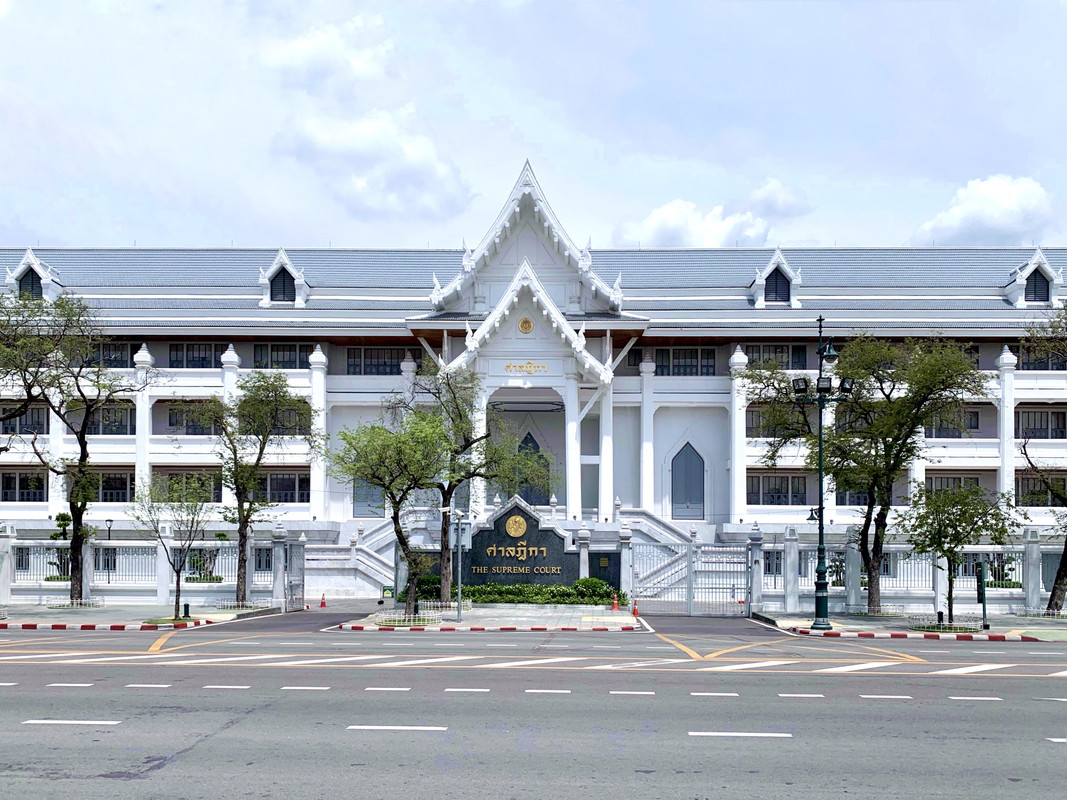
Supreme Court of Justice of Thailand
The legal framework in Thailand is fundamentally rooted in principles of egalitarianism, ensuring equal treatment and non-discrimination under the law. This approach is evident in the stringent legal prohibitions against any form of discrimination, as well as actions that could be construed as an assault or infringement on an individual's personal agency. The laws are specifically designed to protect and uphold the dignity and autonomy of all individuals, reflecting a deep commitment to egalitarian values.
Despite its emphasis on individual rights and personal agency, the Thai legal system does not exclusively promote individualism. Instead, it utilizes the law as a tool to foster personal empowerment and agency across all segments of society, ensuring that every individual, regardless of their background, has the opportunity to exercise their legal rights and freedoms. This inclusive approach is indicative of a broader societal value placed on equality and fairness.
One notable aspect of Thailand's legal system is its apparent impartiality, especially in cases involving high-profile individuals. There is a perceptible trend of holding such individuals accountable for their actions, regardless of their status or influence. High-profile figures in Thailand are frequently subject to legal sanctions, including fines and imprisonment, for offenses that might be considered minor or accidental. This trend of enforcing the law without bias, even in cases involving minimal offenses by influential people, sets the Thai legal system apart from many others around the world. This rigorous application of the law, irrespective of social standing, underscores the country's commitment to egalitarian principles and the rule of law.
◤Major Political Parties
Thailand's political landscape is characterized by a diverse array of political parties, many of which are progressive, green, and lean towards the center-to-left on the political spectrum. This multiplicity of parties contributes to a highly competitive political environment within the country. The presence of these progressive and environmentally focused parties indicates a strong emphasis on issues such as sustainable development, social justice, and environmental conservation within the Thai political discourse.
The multiparty system in Thailand fosters a dynamic political arena where a variety of viewpoints and policy proposals are debated and contested. This diversity of political ideologies and approaches reflects the complexities and varying priorities of the Thai electorate. The competitive nature of this environment is conducive to the evolution and refinement of policy ideas, as parties vie to address the needs and concerns of the populace while distinguishing themselves from their political rivals.
The prevalence of center-to-left-leaning parties within this system points to a societal inclination towards policies that emphasize social welfare, environmental responsibility, and progressive social values. These parties often advocate for policies that prioritize public health, education, and environmental sustainability, reflecting a broader global trend toward green politics and social liberalism.
In summary, Thailand's political landscape is defined by a vibrant and competitive multiparty system, with a notable presence of progressive, green, and center-to-left-leaning parties. This political diversity plays a crucial role in shaping the nation's policies and governance, reflecting the diverse perspectives and aspirations of the Thai people.
◤Democrat Party
The Democrat Party (Thai: พรรคประชาธิปัตย์; RTGS: Phak Prachathipat) holds a significant place in Thailand's political history as the oldest political party in the country. Originally founded as a royalist party, it has evolved over time and currently adopts a stance of progressive conservatism. This ideological position combines a respect for traditional values and institutions with a commitment to gradual and progressive social and economic reforms.
Despite its historical prominence and long-standing presence in Thai politics, the Democrat Party experienced a notable setback during the 2003 Thai General Election. In this election, the party did not secure any seats in the parliament, a situation attributed to a specific set of circumstances rather than a general decline in its overall support. One of the key factors in this electoral outcome was a breach of its traditional voter base. The party narrowly lost in many of its stronghold constituencies, indicating a slight but significant shift in voter preferences.
Additionally, the party's electoral strategy and campaign approach were factors in this outcome. The Democrat Party faced challenges in expanding its appeal beyond its traditional support base, particularly in areas traditionally dominated by rival parties. The lack of proactive measures to gain popularity in these rival voter base areas contributed to its inability to secure parliamentary representation in that election.
The Democrat Party in Thailand positions itself as a centrist entity in the country's political spectrum, advocating for moderation and stability over radical changes. This stance reflects the party's approach to policy-making, which is characterized by a degree of fluctuation and adaptability to the changing political and social environment. The party's self-description as "the best choice other than radical changes" underscores its commitment to gradual, measured progress.
On social issues, the Democrat Party exhibits a complex stance. It advocates against social hierarchy, emphasizing egalitarian principles and the dismantling of entrenched class structures. However, this progressive view on social equality is juxtaposed with a more conservative stance on immigration, where the party supports anti-immigration policies. This combination of views represents the party's effort to balance progressive social values with a more cautious approach to demographic changes.
In terms of regional policy, the Democrat Party is a strong proponent of Thai hegemony within Southeast Asia. It actively supports the economic expansion of Thai corporations into neighboring countries, viewing this as a strategy to bolster Thailand's influence and economic clout in the region. The party perceives the Operation Guardian Harmony patrolling mission as a tool not only to protect regional interests but also to serve as a deterrent, encouraging neighboring countries to align more closely with Thailand's regional agenda.
Regarding international relations, the Democrat Party advocates for maintaining the current status quo in Thailand's relationships with Western powers like the United States and the United Kingdom. The party's view is that Thailand need not seek deeper engagement with Western nations, instead prioritizing its own national interests and the well-being of its people. This stance contrasts with the positions of its political rivals, who may advocate for a more globally oriented approach, emphasizing common human interests and international collaboration. The Democrat Party's focus on national priorities over international cooperation reflects its centrist, pragmatic approach to foreign policy, centered on the protection and advancement of Thai interests.
◤Thai Rak Thai Party
The Thai Rak Thai Party, established in late 1998, is a prominent political entity in Thailand, known for its progressive, left-wing stance. It espouses principles of egalitarianism, environmentalism, humanism, and social liberalism. The party's formation occurred just before the dissolution of the first parliament of the Republic of Thailand, which was led by the Democrat Party.
Since its inception, the Thai Rak Thai Party has made a significant impact on Thai politics, achieving remarkable success in the general elections. It secured victory in both the 1999 and 2003 elections, either leading a coalition government or governing as a single-party administration. The party's ascendancy to the forefront of Thai politics has been often described as a "miracle," particularly notable for securing first place in the 1999 election, just four months after its formation.
The party's ability to form and lead a coalition government contributed to Thailand being recognized as a world power shortly before the end of its term. This recognition is a testament to the party's effective governance and its influence on the international stage.
In the 2003 election, the Thai Rak Thai Party achieved an overwhelming victory, securing a supermajority with 420 seats in the parliament and an additional 50 seats in the senate. This electoral triumph marked the first instance in Thai history where a single political party was able to form a government on its own. The success of the Thai Rak Thai Party in this election reaffirmed its "miracle" status in Thai politics.
Following the 2003 election, the party's success led to a significant realignment in the Thai political landscape. Other political parties, in response to losing almost all their seats in the parliament, underwent drastic shifts in their political positions, aligning more closely with the policies and ideologies of the Thai Rak Thai Party. This shift demonstrates the profound influence of the Thai Rak Thai Party on the political discourse and direction of Thailand, shaping the nation's political landscape in the early 21st century.
The Thai Rak Thai Party, distinguished by its progressive stance, maintains a distinct ideological position in the Thai political spectrum, particularly in contrast to the Democrat Party, its principal political rival. The Democrat Party advocates for progressive conservatism, emphasizing gradual social and economic reforms within a conservative framework. In contrast, the Thai Rak Thai Party's approach is characterized by a strong commitment to common humanity interests, diverging significantly from the Democrat Party's focus on international relations and national interests.
A key tenet of the Thai Rak Thai Party's philosophy is the belief that a nation's strength is not solely determined by its military might or global influence, but rather by its commitment to humanitarian causes. This belief underscores the party's focus on addressing global human concerns and fostering a compassionate approach to governance.
The party's policies are notably pro-immigration, advocating for relaxed border security measures and the fortification of migrant worker rights. This stance includes a commitment to providing housing and support for migrant workers, particularly those from neighboring countries like Myanmar, Laos, and Cambodia. Additionally, the party strongly supports egalitarian principles and is dedicated to the eradication of social hierarchy, promoting a society where all individuals have equal opportunities and rights.
On the regional front, the Thai Rak Thai Party champions the idea of a united and independent Southeast Asia, encompassing all 11 states in the region. The party believes in shared regional responsibility and sovereignty, advocating for the recognition of mutual interests among Southeast Asian nations. This includes supporting the adoption of shared laws and legislation under the ASEAN framework, as well as collaborative security operations.
In terms of international relations, the Thai Rak Thai Party is an ardent supporter of rapprochement, cultural exchange, and fostering amicable relations between Eastern and Western nations. The party advocates for a positive and respectful engagement with Western countries, including the United States and the United Kingdom. This approach extends to both bilateral and multilateral relations, reflecting the party's commitment to constructive and cooperative international diplomacy.
◤Political Reforms and the Role of the Constitution
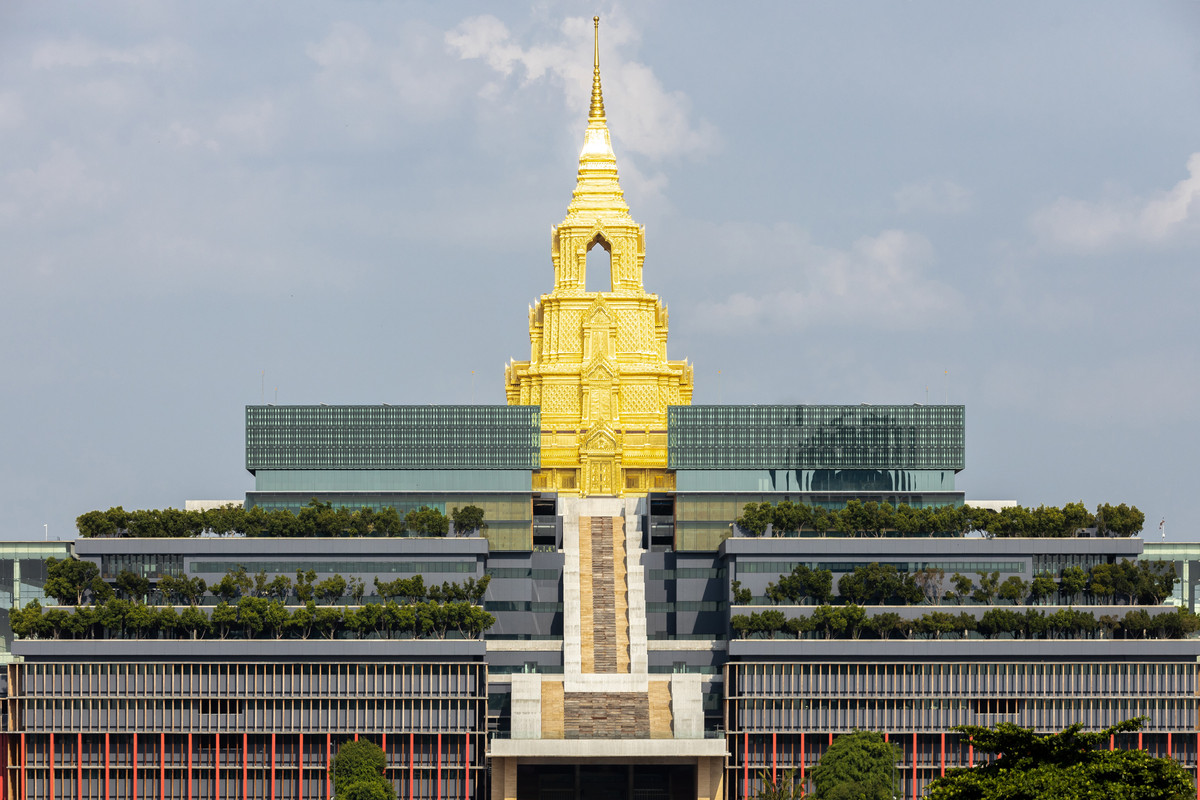
The meeting place of Thailand's legislature, the National Assembly, Sappaya-Sapasathan
The transformation of Thailand from a monarchy to a republic marked a significant turning point in its political and social history. This transition was underscored by the adoption of the 2003 Constitution of the Republic of Thailand, a document that fundamentally redefined the nation's identity and governance. The constitution emerged as a manifestation of a philosophical shift, placing the sovereignty of Thailand firmly in the hands of its people. It encapsulates a profound understanding that the essence of a nation lies in the synergy between its country, government, and citizens. The constitution emphasizes that a country's identity is rooted in its nation, a nation's strength in its government, a government's legitimacy in its people, and the people's significance in their agency, freedom, and dreams.
This transformation brought about sweeping reforms that emphasized human rights, the democratic process, transparency, individual agency, and the collective aspirations of the Thai people. As a result, Thailand has been recognized as a fundamentally egalitarian country, with its foundation built on these principles.
The 2003 Constitution of Thailand stands out as one of the most recently adopted constitutions in the world. It offers a unique definition of what it means to be human and delineates fundamental rights that extend beyond those outlined in the Universal Declaration of Human Rights. The constitution elaborates on the responsibilities of the ruling government towards its population and, crucially, outlines how citizens can exercise their constitutional rights to actively participate in and shape the direction of their country. This framework not only underscores the importance of civic engagement and responsibility but also establishes a robust structure for ensuring the accountability and responsiveness of the government to its people.
◤Human Rights and Progressive Policies
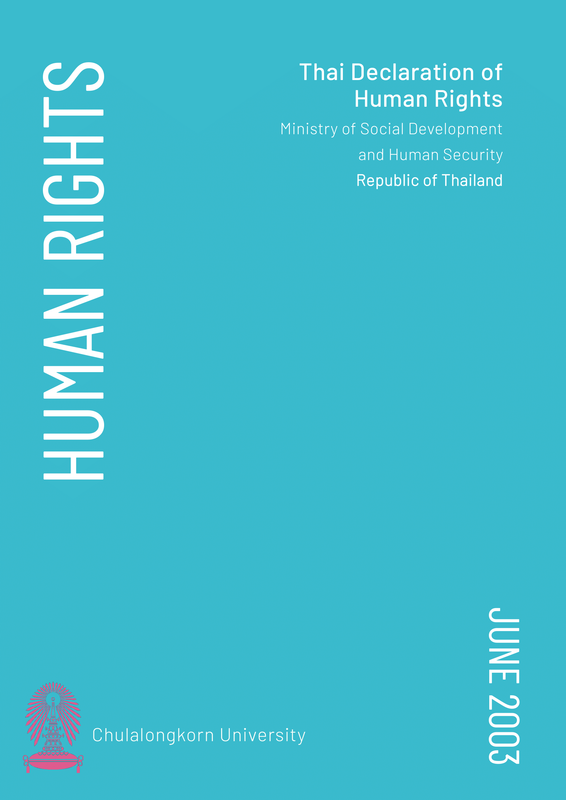
The cover page of the Thai Declaration of Human Rights proclaimed in 2003
In 2003, Thailand's approach to human rights and the establishment of a Welfare State is characterized as both progressive and transformative. The nation boasts a policy of free universal healthcare that extends beyond its citizens to encompass all individuals identifying as human. This inclusive healthcare system is a hallmark of Thailand's commitment to the well-being of all residents within its borders.
In the realm of education, the Thai government plays an initiative-taking role by subsidizing related costs and fees for its citizens who wish to pursue studies. This initiative reflects the country's dedication to fostering an educated and skilled populace. Furthermore, in a notable social welfare policy, each newborn child in Thailand is entitled to a government-opened bank account with an initial deposit of $2000, followed by monthly support of $1000 until they reach the age of eighteen. This program underscores the government's commitment to supporting the youth from infancy through to adulthood.
Worker rights in Thailand are comprehensive and considerate. Employees are entitled to take leave without any impact on their salary. This extends to men, who are allowed leave to care for their pregnant wives or to participate actively in child-rearing, reflecting a progressive stance on gender roles and family responsibilities.
In terms of social policies, same-sex marriage in Thailand is fully legal, with same-sex couples having access to the same benefits and welfare as other couples. The government encourages and supports these couples through programs aimed at preparing them for adoption and educating them on safe sex practices. Additionally, Thailand's sex worker industry is legalized, but the law includes a unique clause. It states, "to ensure the sustainable birth rate of the Thai population, everyone is encouraged to refrain from using such services and engage in monogamous sexual activities." Adultery in Thailand is not only socially taboo but also carries criminal penalties equivalent to those for homicide, reflecting the country's stringent stance on marital fidelity.
On the environmental front, Thailand is poised to become the first nation to fully rely on renewable energy by 2005. The country has implemented various renewable energy initiatives and infrastructures to meet the increasing power demands of its modernizing lifestyle. The private sector plays a significant role in the Thai renewable energy industry, which is among the three most dominant industries in the country. The Ministry of Energy of Thailand maintains a strategic position by holding at least a 30% share in the ten largest renewable energy companies listed on the Thai Stock Exchange. This investment grants the Thai government considerable influence over the direction of these companies. Consequently, the government emerges as the largest purchaser of their power production, signifying its pivotal role in shaping the nation's renewable energy landscape.
Among the various progressive policies and human rights initiatives in Thailand, the Thai Declaration of Human Rights stands out as a particularly significant document. This declaration represents a modern and comprehensive approach to human rights, extending its scope beyond traditional civil and political rights to include contemporary issues such as digital privacy and environmental sustainability.
◤Foreign Policy
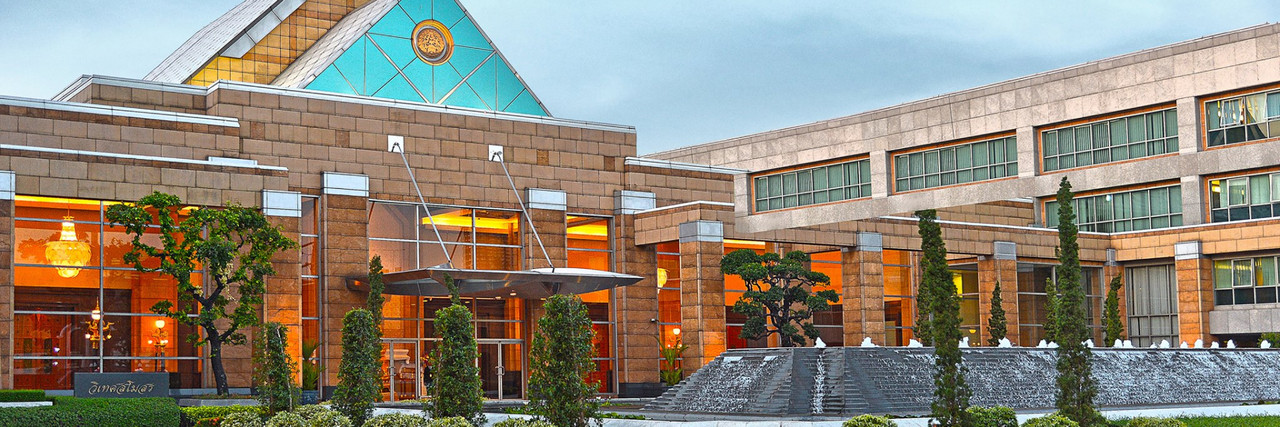
The Ministry of Foreign Affair of Thailand, Bangkok
The Republic of Thailand positions itself as a staunch proponent of equitable power distribution among nations, regardless of their size. This stance is rooted in the Thai Government's commitment to the principle of regional sovereignty, particularly within Southeast Asia. The underlying belief is that nations within a region are best equipped to understand and resolve their internal issues. However, Thailand also upholds a strong doctrine of non-interference, advocating that any nation wishing to engage in the affairs of another must first obtain explicit consent and agreement from that country.
Central to Thailand's regional policy is its support for the reinvigoration of the Association of Southeast Asian Nations (ASEAN). This organization embodies the concept of collective responsibility among member states, and Thailand's dedication to ASEAN reflects its commitment to regional solidarity and cooperation. Thai national laws and policies often demonstrate a preferential treatment towards Southeast Asian nations, reinforcing Thailand's role as a regional guarantor and leader.
In the broader international arena, Thailand actively promotes cultural exchange and the fostering of amicable relations between Eastern and Western countries. Excluding a few exceptions, such as the United Kingdom and the United States, Thailand endeavors to maintain positive diplomatic relations with most Western nations. Despite this, there are instances where Thailand's ideological perspectives come into conflict with the realpolitik approaches prevalent in some Western countries.
Regarding territorial and sovereignty issues, Thailand's stance is clear and nuanced. The Thai government does not recognize the Chinese Nine Dash Line, which lays claim to large swaths of the South China Sea. Additionally, while Thailand does not officially recognize Taiwan as a separate sovereign state, it supports the One China Policy, advocating for a peaceful and unifying solution to the cross-strait relations between China and Taiwan. Thailand maintains a firm position that it would intervene should there be an aggressive move or invasion by either party involved in the cross-strait dispute.
◤International Partners
The Republic of Thailand maintains a network of international diplomatic relations with several countries worldwide, including Mexico, Poland, France, and Turkey. These diplomatic alliances are characterized by shared commitments to good governance, strong military cooperation, and substantial economic ties. Mexico is often cited as one of Thailand's most trusted partners. Various analyses and bilateral communications suggest the presence of a mutual defense treaty between the two nations, highlighting the depth of their strategic partnership. In the realm of international politics, Turkey, referred to historically as the Ottoman Empire, is sometimes viewed as heavily influenced by Thailand. This perspective is based on Turkey's significant reliance on Thailand for various national functions. Notably, this includes the deployment of over 30,000 personnel from the Thai Armed Forces Middle East Command within Turkey. Such military cooperation is indicative of the close ties between Thailand and Turkey, although the characterization of Turkey as a "puppet" state of Thailand is a matter of debate among experts in international relations.
France and Thailand have developed substantial economic ties, including significant technology transfers from Thailand to France. This relationship was further solidified by the Harmonious Accord treaty, under which both nations have engaged in considerable levels of mutual direct foreign investment. This includes both inward and outward investments, reflecting a strong bilateral economic relationship. The partnership with France is often viewed as a testament to Thailand's openness in international relations. This approach is particularly notable given the differing governance styles between the two nations, especially in the context of the recent French Civil War in 2002. Thailand's engagement with France, despite these differences, underscores its commitment to fostering positive international relationships. The formation of the modern French Empire, following the civil conflict, remains a subject of ongoing debate and discussion within Europe. This topic continues to attract attention and analysis, reflecting the complexities and ramifications of the events that transpired in France in the early 21st century.
Poland is recognized as one of Thailand's most enduring international partners. Despite instances of past governmental disagreements, it is widely acknowledged among experts that the strength of people-to-people relationships between the two nations exerts considerable influence on their governments to sustain a robust bilateral relationship. Poland is particularly noted for its military capabilities, especially in light of recent advancements in the modernization of the Polish Armed Forces. These developments position Poland as a significant partner for Thailand in terms of military strength. In the context of naval power, while the Thai Navy is acknowledged as the second largest in the world, following closely behind the United States Navy, there is a prevailing belief among experts that Poland possesses the potential to challenge Thailand's influence in Europe. This potential is regarded by some as surpassing even that of the United Kingdom.
◤Challenges and Criticisms
The Thai Government is not without its challenges and criticism. They have been frequently subjected to disproportionate use of force against any perceived threat. During the border standoff between Thailand and Cambodia, Thailand swiftly launched a bombing campaign near a religious historical site after a Cambodian soldier fired into the Thai border.
They have also been reprimanded for the tendency to impose their democratic and human rights values on other countries. This has been called out by the Israeli Foreign Minister as a form of neocolonialism after Thailand closed its diplomatic mission to Israel.
The Thai Government has been dubbed by the American media that they tend to put themselves in a place that doesn't require them. This is particularly debatable as their involvement in the 2003 Israeli-Palestinian Crisis has made the situation worse.
After the killing of the Egyptian Chief of Foreign Affairs at the Thailand Government House, they faced numerous criticism and backlash. Egypt has revoked its recognition of the Thai nation, dubbing it a dangerous terrorist organization. Most people had a consensus at the time that Thailand had become too confident.
Because the Thai Government places its ideological stance above practical, realpolitik governance, they are frequently criticized by the Western media for their publication of classified information considered by other countries. They hold a strong belief that the general population deserves to comprehend the truth behind the surface and that sometimes compromising traditional secrecy is beneficial to the human population.
◤Economy
◤Overview of the Economy
The economy of Thailand is highly developed free-market economy with social liberalism characteristic. Thailand's economy is among the most open in the world, frequently rank just behind or surpass Singapore's economy. Thailand has low tax rates on business yet considerably high when a corporate excess its carbon footprint limit. Alongside the business-friendly reputation for global and local privately held companies and public companies, various national state-owned enterprises play a substantial role in Thailand's economy. The Ministry of Energy hold a substantial shared on largest renewable energy companies while the Ministry of Public Health holds more than half shares on most medical manufacturing companies and the Ministry of Agriculture and Cooperative often subsides and invest various agricultural companies. With regards to foreign direct investment (FDI), the Thai economy receives lucrative funds flowing into their country, especially from Spain, France, and Turkey.
Thailand relies heavily on its domestic manufacturing industry, which is the result from various sanctions imposed by the United States and the United Kingdom. The Thai economy is a diversified economy, which only 20% of their GDP comes from Bangkok compared to 50% in 1997. Thailand is the largest economy in Southeast Asia and ranks first in income equality in Asia-Pacific. Thailand functions as an anchor economy for the neighboring developing economies of Laos, Myanmar, and Cambodia. In the second quarter of 2003, the unemployment rate in Thailand stood at 0.0574% according to Thailand's National Economic and Social Development Board (NESDB).
◤Major Industries and Sectors
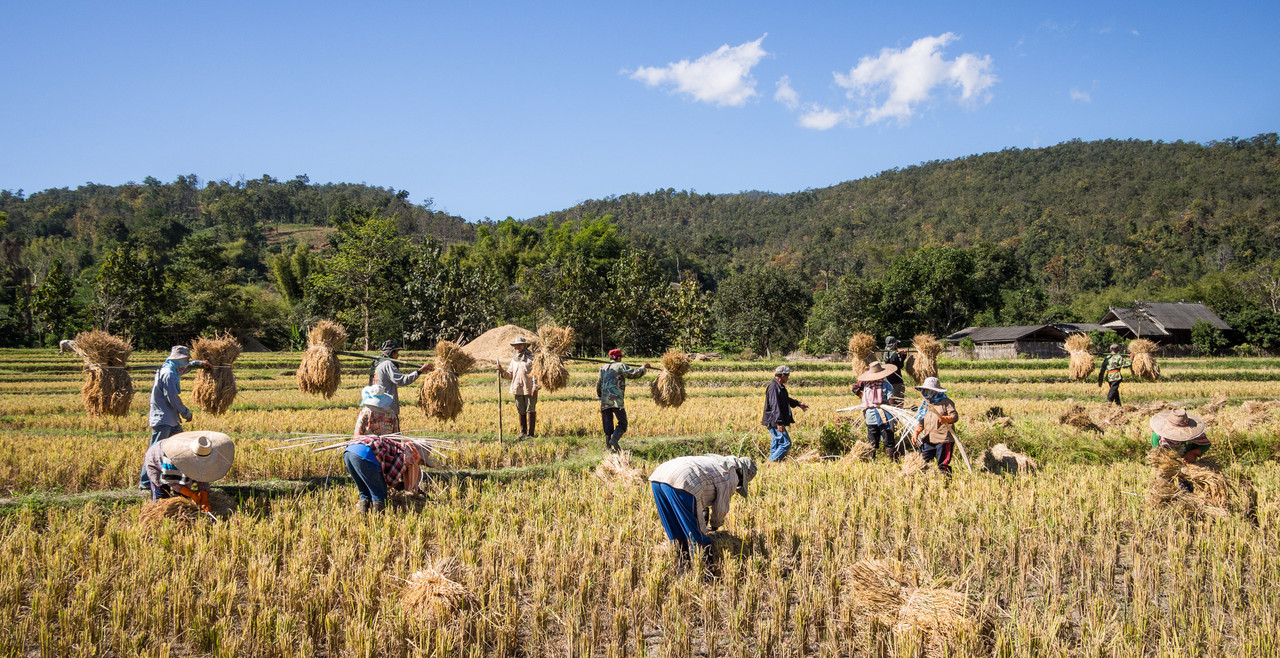
Thailand has long been one of the largest rice exporters in the world. Thirty-two per cent of Thailand's labour force is employed in agriculture.
Thailand's economic landscape is anchored by three pivotal industrial sectors: Renewable Energy, Advanced Manufacturing, and Agriculture. This unique blend allows for an interconnected system where renewable energy not only powers the nation's industrial capabilities but also supports its agricultural sector. The use of renewable energy sources aids in the operation of Thailand's manufacturing industry, providing a sustainable and efficient energy solution. Concurrently, this energy is utilized to equip the agricultural sector with innovative technology and contemporary farming practices, fostering a constructive collaboration between these vital economic components.
A cornerstone of Thailand's renewable energy sector is the Pan-Asian Renewable Energy Grid. Scheduled for completion in late 2004, this ambitious project is poised to play a crucial role in shaping the Thai Renewable Energy Market. With this grid in operation, Thailand is on track to finalize its transition towards sustainability by 2005. The nation plans to not only meet its domestic energy needs sustainably but also to export surplus energy generated by its large-scale projects to neighboring countries such as Myanmar, Laos, Cambodia, and Malaysia. This initiative underlines Thailand's commitment to regional energy cooperation and its role as a key player in Southeast Asia's sustainable energy landscape.
The Chiang Mai Medical Electronics Manufacturing Industry Sector stands as the largest industry sector in Thailand. It is instrumental in supplying the nation with domestically produced modern medical equipment, thereby reducing dependence on international imports. This sector's primary focus is on the manufacturing of advanced medical devices and technology, which are essential for the healthcare industry. The export strategy of this sector is primarily targeted towards Southeast Asian nations, aligning with Thailand's broader goal to be a regional hub for affordable and modern medical equipment. This not only enhances Thailand's influence in the region but also contributes to the improvement of healthcare standards in neighboring countries.
Thailand's Agriculture sector has experienced significant growth and modernization since the Rattanokin Era. This transformation can be attributed to the adoption of advanced equipment integrated with modern technology, which has markedly increased farming efficiency. Additionally, research centers dedicated to sustainable farming play a pivotal role in this sector. These centers focus on integrating technology into agricultural practices, thereby enhancing productivity and sustainability. The robustness of Thailand's agricultural sector is a demonstration to its successful integration of technology and innovation, positioning it as a key component of the nation's diverse and dynamic economy.
◤Regional Agri-Tech Centers
Since the completion of Thailand's nationwide project aimed at developing and improving the water supply system, the Northeast region of Thailand, commonly referred to as Esan, has witnessed the most significant transformation. Historically, Esan has been known as a drought-prone area, regularly suffering from water scarcity. However, the establishment of the water supply system in 2002 has radically altered the region's agricultural landscape. The improved water availability has led to a remarkable increase in agricultural activities, with at least a million people either returning to or newly engaging in the agriculture sector within the region. This surge in agricultural productivity has positioned Esan on a trajectory to potentially surpass the farming output of Thailand's Central region. In line with these developments, the Thai Government, under its Diversification Act, has committed over $400 million to the construction and development of four Regional Agri-Tech Centers located in Chiang Ma, Ubon, Nakhon Si Thammarat and Chai Nat. Each center spans an approximate area of 50 acres and is designed to be a hub for agricultural innovation and technology.
The four Regional Agri-Tech Centers represent a significant advancement in agricultural research and development. These centers are organized into three distinct functional areas, each equipped with advanced facilities and technologies designed to foster innovation and efficiency in agriculture.
1. Sustainable Farming Research: This area is dedicated to pioneering environmentally sustainable agricultural practices. It features state-of-the-art greenhouses with adjustable climate controls, allowing researchers to create specific environmental conditions. These greenhouses are complemented by soil beds equipped with nutrient monitoring systems. By manipulating variables such as humidity, temperature, and soil pH, researchers can conduct in-depth studies on how these factors influence crop growth, health, and resilience against environmental stressors.
2 . Crop Yield Optimization Labs: These labs are equipped with cutting-edge gene sequencing and editing facilities, including CRISPR technology, enabling advanced research in plant genetics. Hyperspectral imaging systems provide non-invasive methods to monitor plant health and track growth stages accurately. The labs also incorporate sophisticated data analytics platforms, allowing for real-time analysis of experimental data. This integration of technology enables researchers to rapidly adapt and optimize research protocols, aiming to enhance crop yields and genetic resilience.
3. Automation & Robotics Development: Focused on the development of agricultural machinery and robotics, this area includes fabrication labs equipped with CNC machines, 3D printers, and assembly lines for prototyping and testing new technologies. An adjacent testing field allows for real-world trials of the machinery, including automated drones for aerial crop monitoring and autonomous tractors for field operations. This facility is pivotal in advancing the automation and mechanization of farming practices.
Each center maintains a central data repository, which serves as a secure vault for all research data generated within the facilities. This data is accessible to authorized researchers and staff for cross-referencing and collaborative studies, ensuring a cohesive and integrated approach to agricultural research. The center’s data infrastructure is designed for high availability and low latency, with robust redundancy measures to safeguard data integrity and ensure continuous availability. These technological and infrastructural advancements position the Thai Regional Agri-Tech Centers at the forefront of agricultural innovation, contributing significantly to the country's agricultural sector and broader economic development.
◤Coastal Fisheries and Aquaculture Development
Thailand's fishing industry, particularly in areas like Phuket and Krabi, has been steadily growing and plays a crucial role in the country's economy. These regions serve as pivotal fishing platforms, supporting the adjacent provinces of Phang Nga and Trang. Historically, the inshore and offshore waters of Thailand have been vital sources of fish, which is a key protein source for the Thai population. In 2001, the average annual fish consumption in Thailand was reported to be 32.4 kilograms per capita, contributing approximately 10–14 grams of protein per capita per day. Fish constitute 40.5% of the animal protein sources and 17.6% of the total protein consumed in Thailand. It's likely that actual fish consumption is higher than reported figures, as smallholder catches often do not enter the marketplace and are consumed locally.
The $675,000,000 commitment to nine Coastal Fisheries and Aquaculture Development facilities in Phuket, Krabi, Songkhla, Surat Thani, Prachuap Khiri Khan, Samut Songkhram, Samut Sakhon, Samut Prakan, and Prachuap Khiri Khan represent a significant advancement in sustainable seafood production. Each facility, covering an area of approximately 100 acres, is strategically located to facilitate easy access to both domestic and international markets, leveraging their proximity to key maritime routes. The facilities are divided into two primary sectors: Open Ocean Fisheries and Controlled Environment Aquaculture, both of which are designed to function in a synergistic manner. Shared resources between these sectors include water treatment plants, feed mills, and processing units, enhancing operational efficiency and sustainability.
1. The Open Ocean Fisheries sector is equipped with a fleet of fishing vessels that adhere to sustainable fishing practices. These vessels are outfitted with advanced technologies such as sonar and GPS systems for efficient navigation and precise fish location. Additionally, they are fitted with bycatch reduction devices to minimize the unintentional capture of non-target species. Onboard processing units allow for the immediate preservation of the catch in temperature-controlled environments, ensuring the freshness of the seafood.
2. In the Controlled Environment Aquaculture sector, various culture systems are employed. These include recirculating aquaculture systems (RAS), flow-through systems, and open-net pens, each designed for specific species ranging from finfish like grouper to shellfish such as shrimp. Automated sensors continuously monitor water quality, measuring parameters like pH, dissolved oxygen, and ammonia levels. This technology enables real-time adjustments to be made to the aquatic environment, ensuring optimal conditions for aquaculture.
The Coastal Fisheries and Aquaculture Development facilities in Phuket and Krabi, Thailand, incorporate comprehensive systems to ensure the sustainability and efficiency of their operations. Central to these facilities is a Water Treatment Plant that serves both the Open Ocean Fisheries and Controlled Environment Aquaculture sectors. This plant is equipped with advanced mechanical and biological filtration systems, as well as UV sterilization units, which are essential for maintaining high water quality standards necessary for healthy aquatic environments. A specialized Feed Mill is also part of the infrastructure, producing a range of feeds tailored to the specific requirements of different marine species at various life stages. The emphasis on sustainable ingredients, such as algae-based proteins and oils, highlights the commitment to environmental responsibility and the reduction of the ecological footprint of aquaculture activities.
The facilities further include a Processing and Packaging Unit, where both caught and cultured seafood are handled. This unit is equipped with conveyor systems, filleting machines, and vacuum packaging lines, ensuring efficient and hygienic processing of seafood products. The operation of this unit adheres to international food safety standards, guaranteeing that the seafood products meet global quality and safety benchmarks. Data management is a pivotal aspect of the facilities' operations. A centralized data center collects and analyzes a wide array of data from various operations across the facilities. This data encompasses catch statistics, water quality parameters, feed conversion ratios, and other vital performance indicators. Utilizing advanced analytics software, the data center conducts predictive modeling and optimization studies to enhance the efficiency and effectiveness of the fisheries and aquaculture operations.
This integrated approach to fisheries and aquaculture, combining state-of-the-art technology with sustainable practices, demonstrates Thailand's forward-thinking strategy in seafood production. The sophisticated management and processing systems underscore the country's commitment to maintaining high standards in its fishing industry while prioritizing environmental sustainability and food safety.
◤Advanced Manufacturing Cluster
The manufacturing sector in Thailand, characterized by its competitiveness, benefits from a combination of factors including the availability of raw materials, affordability of labor, and the adoption of innovative technologies. Notably, since 1995, the sector has experienced significant growth, establishing itself as one of the three largest economic sectors in Thailand. This growth can be attributed to the country's strategic focus on industrial development, leveraging its resources and technological advancements to enhance its position in the global manufacturing landscape.
The Advanced Manufacturing Cluster in Rayong, covering an expansive area of 200 acres, is a strategically designed industrial hub that aims to advance manufacturing technologies through innovation. It is methodically divided into three distinct sections, each specializing in a unique aspect of manufacturing: 3D Printing and Additive Manufacturing, Robotics and Automation, and Nanotechnology Research and Development.
In the 3D Printing and Additive Manufacturing area, the focus is on utilizing industrial-grade 3D printers that can handle a diverse array of materials, ranging from various polymers to different metals. This zone is comprehensively equipped, featuring facilities for both pre- and post-processing tasks. These include material preparation, heat treatment, surface finishing, and a specialized computational unit for CAD/CAM operations, simulations, and optimizations, ensuring a holistic approach to additive manufacturing.
The Robotics and Automation sector is dedicated to the evolution and testing of industrial robotics, automated assembly lines, and machine vision systems. It is notable for its modular assembly stations and testing bays, which are designed for flexible reconfiguration, simulating a variety of manufacturing settings. The integration of advanced control systems into the equipment facilitates real-time monitoring and adjustments, enhancing performance and operational efficiency.
The Nanotechnology Research and Development segment offers a controlled setting for the exploration and manipulation of substances at the molecular or atomic scale. This highly specialized facility boasts features like cleanrooms that adhere to ISO Class 5 standards, electron microscopes, and equipment tailored for processes such as thin-film deposition and etching, positioning it at the forefront of nanotechnology research.
Central to the cluster's functionality is the Material Testing Lab, which provides critical support to all zones. This laboratory is outfitted with a range of instruments for mechanical testing, spectroscopy, and thermal analysis, ensuring that the materials used or produced within the cluster adhere to stringent quality standards.
Data management and analytics are fundamental to the cluster's efficiency. A central data center aggregates and processes information from numerous sensors and control systems across the facility. Advanced analytics software is utilized for various operational needs, including predictive maintenance, process optimization, and quality control, underlining the cluster's commitment to technological advancement and operational excellence.
Additionally, the cluster encompasses a Business Incubation Center, which plays a pivotal role in fostering startups and small to medium-sized enterprises (SMEs) in the advanced manufacturing domain. This center not only offers office space and shared resources but also provides access to the cluster's state-of-the-art manufacturing facilities. This initiative allows emerging companies to develop and test their technologies without substantial initial capital investment, promoting innovation and growth in the advanced manufacturing sector.
◤Tourism
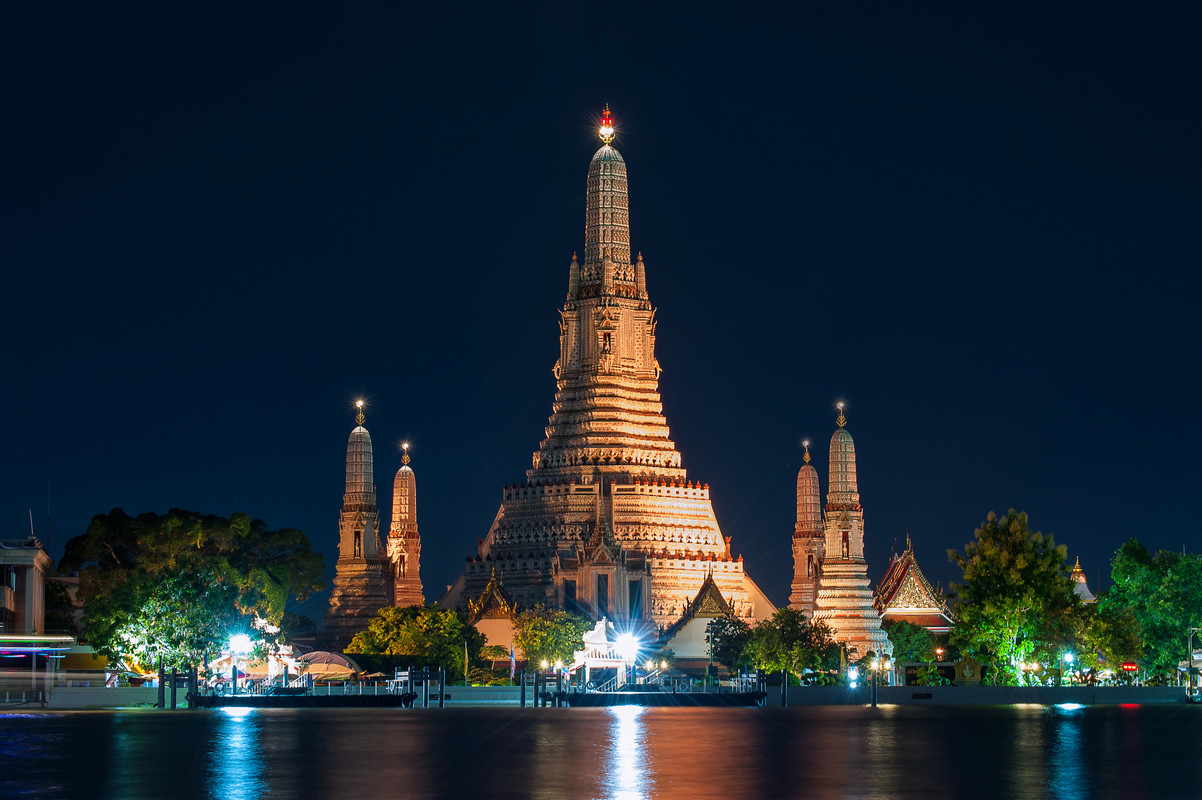
Wat Arun, Bangkok is among the best known of Thailand's landmarks
Tourism plays a crucial role in the Thai economy, contributing approximately 6% to the nation's Gross Domestic Product (GDP). In 2003, Thailand positioned itself as a leading tourist destination on the global stage, drawing 39.8 million international visitors and becoming the most visited country in Southeast Asia for that year.
The appeal of Thailand's tourism is diverse, with varying attractions for visitors from different regions. Asian tourists are particularly attracted to Bangkok, Thailand's bustling capital, which offers a combination of historical, natural, and cultural attractions. Western tourists frequently visit Bangkok and its surrounding areas, but many also venture to Thailand's southern beaches and islands, renowned for their stunning landscapes and lively coastal culture. Conversely, the northern regions of Thailand attract those interested in trekking and adventure travel. This area is celebrated for its forested mountains and the presence of diverse ethnic minority groups, offering a blend of cultural immersion and natural exploration.
In contrast, the Isan region in Northeast Thailand receives comparatively less tourist attention, despite its rich cultural heritage and traditional lifestyle. Isan's unique cultural and historical aspects remain less explored by international tourists.
To enhance tourist safety and convenience, Thailand has implemented a specialized tourism police force. This unit is operational in key tourist locations, providing assistance and support to visitors. For emergency situations or urgent inquiries, tourists can access an emergency telephone number to reach the tourism police, ensuring prompt and effective response to their needs.
◤Sustainable Tourism
Thailand has initiated a $200 million Sustainable Tourism Infrastructure project in Pai and Hua Hin, focusing on the development of eco-friendly tourism facilities in these popular destinations. The primary goal is to establish sustainable hotels and nature trails that prioritize minimal environmental impact, conservation efforts, and positive contributions to local communities. The project is committed to obtaining international sustainability certifications to underscore its dedication to environmental stewardship and adherence to best practices.
In constructing sustainable hotels, the project emphasizes the use of green building materials, including locally sourced bamboo, reclaimed wood, and natural stone, to reduce the carbon footprint and support local economies. These hotels are thoughtfully designed to harmonize with their natural surroundings, incorporating features like green roofs, living walls, and expansive windows for ample natural lighting. To further enhance environmental responsibility, the hotels integrate energy-efficient technologies and water conservation measures, such as solar panels, high-efficiency HVAC systems, rainwater harvesting, greywater recycling, and in-house water treatment plants. These initiatives not only reduce the hotels' ecological impact but also contribute to the comfort and well-being of their guests.
The project also entails the creation of nature trails, providing visitors with an opportunity to explore and appreciate the local ecosystem. Careful planning ensures these trails minimize disruption to natural habitats and wildlife. Constructed with permeable materials like gravel, wood chips, or mulch, the trails prevent soil erosion and water runoff. Educational signage along the trails, made from sustainable materials like recycled metal or wood, imparts information about the local flora and fauna, fostering environmental awareness among visitors. The features of these trails include:
- A 3-km loop trail that passes through a bamboo forest, a waterfall, and a hot spring
- A 5-km linear trail that follows the river and offers scenic views of the mountains and the valley
- A 7-km circular trail that climbs up a hill and showcases the diversity of the vegetation and the wildlife
- An estimated 500 direct and indirect jobs created by the project
- A 10% increase in income for local farmers and artisans
- A 15% increase in visitors to the local cultural and historical sites
- LEED Gold for the hotel in Pai
- BREEAM Excellent for the hotel in Hua Hin
- Green Globe for the nature trails
As of the latest estimates, Thailand's labor force comprises approximately 55.6 million employed individuals, reflecting the diverse economic sectors that drive the nation's economy. The distribution of this workforce across various sectors is indicative of Thailand's mixed economic structure. About 32 percent of the workforce is employed in the agricultural sector, highlighting the country's strong agrarian roots and the significance of agriculture in rural areas. The service sector employs around 28 percent of the labor force, underscoring the growing importance of services, tourism, and retail in Thailand's economy.
The industrial sector accounts for the largest share, employing 40 percent of the workforce. This considerable proportion reflects Thailand's industrial growth and diversification, encompassing manufacturing, construction, and other industrial activities. The prominence of the industrial sector signifies Thailand's status as a developing economy transitioning towards more industrial and technological activities.
In addition to its domestic workforce, Thailand hosts a substantial number of migrant workers, totaling 5,339,834. These migrant workers predominantly originate from neighboring countries such as Cambodia, Laos, and Myanmar. The majority of these workers are officially registered, integrating into various sectors of the Thai economy. They often occupy roles in agriculture, construction, manufacturing, and services, contributing significantly to the Thai economy while also presenting social and policy challenges regarding their rights and integration into Thai society. The presence of a large migrant workforce is a testament to Thailand's economic draw in the region and highlights the interconnected nature of labor markets in Southeast Asia.
◤Armed Forces
◤Overview
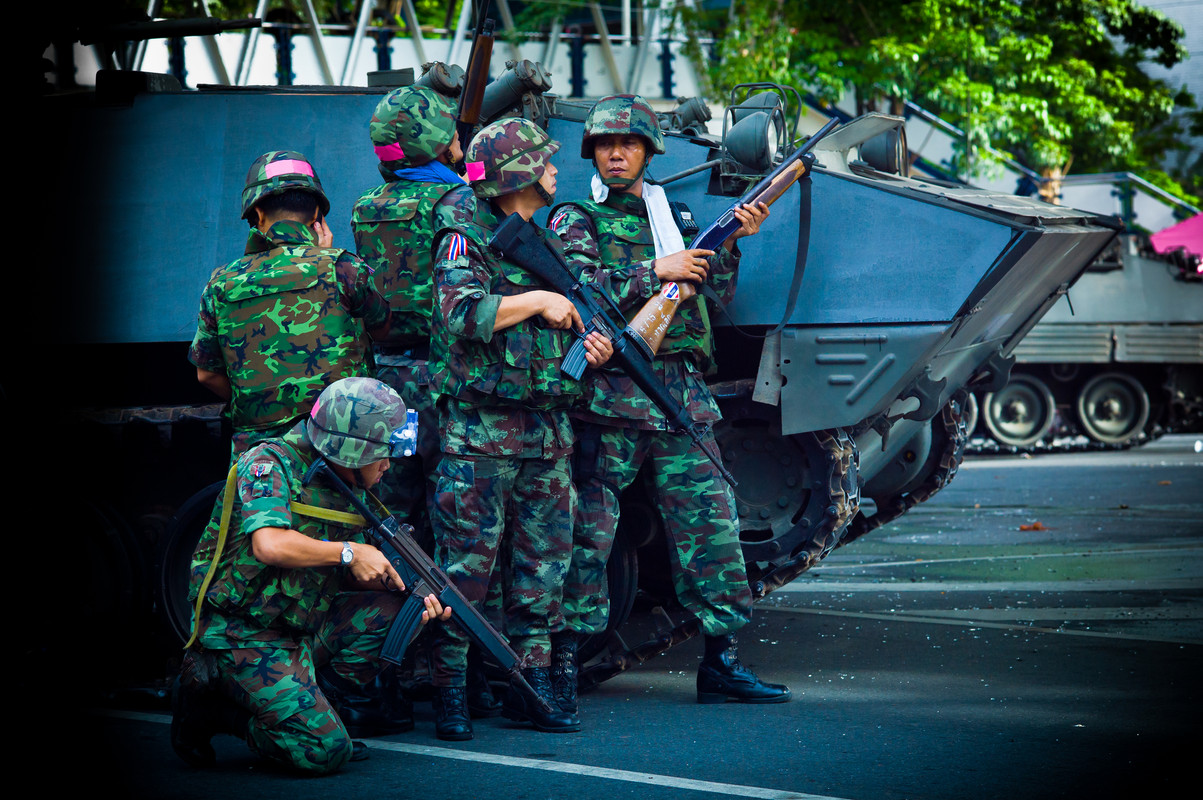
Thai Soldiers during the Pattani Insurgency in 1999
The Republic Thai Armed Forces (กองทัพไทย; RTGS: Kong Thap Thai) constitute the military of the Republic of Thailand. It consists of the Republic Thai Army (กองทัพบกไทย), the Republic Thai Navy (กองทัพเรือไทย), and the Republic Thai Air Force (กองทัพอากาศไทย). It also incorporates various paramilitary forces.
The Thai Armed Forces have a combined manpower of 727,572 active duty personnel and another 2,000,000 active reserve personnel. The head of the Thai Armed Forces (จอมทัพไทย, Chom Thap Thai) is the Supreme Commander of the Thai Armed Forces, who is also the Chief of the Defense Forces of Thailand, and this position is lower than the Minister of Defense, which is also lower than the Prime Minister. But, technically, all three positions have the same authority over the entire Armed Forces, and the Supreme Commander is responsible for Tactical and Strategic Operations, the Defense Minister for administrative work, and the Prime Minister for authorization.
The armed forces are managed by the Ministry of Defence of Thailand, which is headed by the Minister of Defence (a member of the cabinet of Thailand) and commanded by the Republic Thai Armed Forces Headquarters, which in turn is headed by the Chief of Defence Forces of Thailand.
According to the constitution, serving in the armed forces is a voluntary decision of Thai citizens. Thailand uses a volunteer system with high and comprehensive welfare and benefits to compensate anyone joining the military. Their welfare system is considered to be better and broader than the already extensive Welfare State.
The Republic Thai Armed Forces' official role is the protection of the sovereignty and territorial integrity of the Republic of Thailand and the safety and well-being of its population. They are also responsible for ensuring public order and participating in social development programs by aiding the civilian government. The armed forces are also charged with assisting victims of national disasters and drug control. Apart from these roles, they are focused on providing humanitarian and peacekeeping support.
◤Humanitarian and Peacekeeping Contribution
The Republic of Thai Armed Forces has established itself as a committed and active military force with a strong focus on humanitarian relief and international peacekeeping. Renowned for their proactive involvement, the Thai Armed Forces are considered among the foremost contributors to peacekeeping missions globally. Since the inception of the Global Assembly, a key international forum, the Republic Armed Forces have consistently demonstrated their readiness to deploy volunteers to conflict-affected nations, often being one of the first to respond even before international attention is fully garnered.
A notable instance of this commitment was evident in 1999 when Thailand, alongside Israel, was one of the only two nations to send humanitarian forces to South Africa during the Swedish occupation and incursion. The Thai contingent played a crucial role in this mission, providing substantial assistance and relief to approximately half a million South Africans, particularly in the northern region. This effort highlighted Thailand's capacity and willingness to contribute significantly to international humanitarian efforts.
In 2002, during the brutal Congolese border skirmish, Thailand distinguished itself by deploying more humanitarian forces to the region than any other nation. Notably, they were the only country actively providing relief within Congo at the time. Thailand's response was both swift and substantial, marking them as the first nation to extend significant support to Congo, even amidst widespread international skepticism regarding the Congolese government.
The Thai Armed Forces' capability for rapid and efficient response was further demonstrated during the Thai Airways International Flight TG409 Incident. In this operation, the Thai Navy deployed over 4,600 personnel at sea and achieved the remarkable feat of recovering all debris, human remains, and aircraft structure within a span of 72 hours.
Another significant humanitarian effort was the Thai Military's response to the Tokyo massacre, where they established the Humanitarian Aid Forces to Japan (HAFJ). The HAFJ was a major undertaking, involving over 17 Landing Platform Docks and carrying more than 10,000 humanitarian volunteers. This mission underscored the Thai Military's dedication to humanitarian causes and its ability to mobilize quickly and effectively in response to international crises. Through these actions, the Thai Armed Forces have consistently demonstrated their commitment to humanitarian aid, peacekeeping, and rapid response capabilities on the global stage.
◤Military Capability
The Republic Thai Armed Forces, renowned for their sophisticated, modern, and well-funded military structure, have emerged as one of the most rapidly expanding and controversial armed forces globally. The investment in training reflects this growth, with the standard training cost for a regular soldier being $50000 for a 16-week program. Many independent and neutral news and research institutions have lauded the Thai Military, describing it as the most powerful in Asia.
Despite a relative lack of historical military engagement compared to nations like the US or the UK, Thai military academies are recognized as some of the world's leading military educational institutions. The Thai military focuses on adaptability and interoperability, compensating for its limited historical warfare experience. This approach includes access to advanced technologies, especially in the realm of modern electronic warfare, enhancing their capabilities.
◤Republic Thai Army
The Republic Thai Army, a key component of the Thai Armed Forces, is recognized for its formidable capabilities. It stands out for its substantial funding, access to state-of-the-art equipment, advanced training programs, and a deep understanding of comprehensive tactical strategies, particularly in comparison with other military forces in the Southeast Asia region.
The proficiency of the Thai Army was notably demonstrated during the Fourth Indochina War. In this conflict, the army successfully occupied about 80 percent of Laos's challenging terrain within a span of just two weeks, showcasing its operational effectiveness. Another instance of the army's capabilities was evident in the conflict related to the Preah Vihear dispute with Cambodia. Despite facing numerical inferiority and strategic disadvantages, the Thai Army inflicted significant casualties on Cambodian forces, underscoring its tactical acumen.
In addition to its operations within Southeast Asia, the Thai Army also maintains a specialized mechanized division stationed in Tatvan/Bitlis, Turkey. This division is renowned for being one of the most sophisticated and well-equipped military units in the Middle East, which further enhances the reputation of the Thai Army as an exemplary and highly capable military force.
◤Republic Thai Navy
The Republic Thai Navy, often referred to as the Republic Navy, serves as Thailand's primary force for power projection abroad. With 104,630 active duty service members and 331 commissioned ships, it operates as a blue water navy. Additionally, the Republic Navy oversees a division of 21,000 marines, frequently involved in border activities. During peacetime, the Republic Navy ensures the presence of at least two carrier strike groups, officially termed Naval Expeditionary Groups, within Asia.
◤Republic Thai Air Force
The Republic Thai Air Force maintains a sizeable and technologically advanced fleet, encompassing a diverse array of aircraft. Its operations, particularly those involving fixed-wing aircraft, are primarily focused within Southeast Asia and its neighboring regions. In contrast, the Air Force's rotary-wing capabilities are significantly enhanced through collaboration with the Navy, particularly via the support of the Navy's helicopter carriers.
It is important to note that the Thai Air Force does not independently manage any rotary-wing aircraft. Instead, the ownership and operational responsibilities of these aircraft are shared with the Navy. The Air Force's strategic emphasis is on fixed-wing aerial warfare, delegating the rapid response to rotary-wing threats primarily to the Thai Army.
Among its significant assets, the Thai Air Force is recognized as one of the largest operators of F-16 fighter jets globally, second only to the United States. This extensive fleet of F-16s underscores the Air Force's considerable capabilities and its prominent role in regional aerial defense. Moreover, the Republic Thai Air Force is reported to operate at least 50 Saab JAS 39 Gripen aircraft, further demonstrating its commitment to maintaining a diverse and modern aerial fleet.
◤Republic Special Force
The special forces of Thailand operate under the command of the Republic Thai Armed Forces Special Warfare & Operation Command (SWOC). This elite group is comprised of approximately 4,500 personnel, strategically distributed across a minimum of 26 specialized units. The SWOC is organized into four distinct sub-commands, each with its specific focus and area of expertise:
1. Republic Thai Army Special Warfare Command: This sub-command specializes in ground-based operations, including unconventional warfare, reconnaissance, and direct-action missions.
2. Naval Special Warfare Command: This unit is responsible for maritime operations, including amphibious warfare, underwater demolition, and coastal patrol.
3. Air Force Security Force Command: This command focuses on air-based special operations, including airfield security, airborne operations, and support for aerial missions.
4. Special Operations Cyber and Psychological Command: A relatively recent addition, this command is tasked with cyber warfare and psychological operations, reflecting the evolving nature of modern warfare and the importance of digital and informational strategies.
◤Republic Paramilitary Force
In addition to its regular armed forces, Thailand maintains a substantial paramilitary force, consisting of 69,000 personnel. These forces are composed entirely of volunteers who, despite their enthusiasm for military service, do not meet the criteria for enlistment in the primary branches of the Thai Armed Forces. The primary role of these paramilitary units is border patrol, where they play a crucial role in maintaining national security and sovereignty. Often, these forces are the first responders to threats at the border, showcasing their readiness and importance in safeguarding Thailand's territorial integrity.
◤Republic Thai Military Reserve Force
The Republic Thai Armed Forces maintains a significant component of its military structure in the form of a military reserve force. This reserve force, predominantly composed of volunteers, plays a vital role in supplementing and supporting the active-duty personnel of the Thai military. As of the latest data, the Thai military reserve force comprises approximately two million reservists. This substantial number positions Thailand as having one of the largest military reserve forces globally. In the context of Southeast Asia, Thailand's reserve force is second in size only to Vietnam, which holds the distinction of having the largest reserve force in the region. The existence of such a large reserve force is indicative of Thailand's strategic approach to national defense. It reflects the country's commitment to ensuring a prominent level of preparedness and the ability to augment its active military capabilities rapidly in response to various security challenges or emergencies. The reservists undergo periodic training and are expected to be ready for mobilization when called upon, thus providing a critical backup to the regular armed forces.
◤Defense Capability
The Thai Air and Coastal Defense Command (ACDC), a crucial component of Thailand's defense infrastructure, operates the National Air Defense System of Thailand (NADST). This system is equipped with advanced surveillance and early warning technology, significantly enhancing Thailand's air defense capabilities. The NADST includes 8 AN/TPS-77 L-Band, 3-D, tactical transportable long-range air surveillance radars, which are instrumental in providing comprehensive air surveillance. Additionally, the system currently employs 10 Saab 340 AEW&C (Airborne Early Warning and Control) aircraft, with plans to expand this fleet to 30 units.
The NADST stands out in terms of technological sophistication and operational comprehensiveness, particularly when compared to the air defense systems of other Southeast Asian nations. Its capabilities ensure robust and effective monitoring of Thailand's airspace, significantly bolstering national security. During peacetime, the ACDC proactively deploys at least 4 Saab 340 AEW&C aircraft to maintain continuous surveillance over strategic areas. These areas include the Andaman Sea, the Gulf of Thailand, and the Strait of Malacca, all of which are of immense strategic importance due to their geographical positioning and the volume of maritime traffic.
◤Strategic Interests
The Thai Defense Capability Report 2003, in its unclassified version, delineates Thailand's strategic goals and guiding principles in the context of its national defense and international relations. The overarching strategic objective of Thailand, as articulated in the report, is the establishment of a world that is free, fair, just, and peaceful. This vision forms the cornerstone of Thailand's defense and foreign policy.
Central to Thailand's strategic outlook is the identification of its adversaries. According to the report, Thailand perceives its enemies as those entities or nations that do not align with a vision of a world that is free, open, prosperous, and secure. This perspective underscores Thailand's commitment to promoting and defending the values of freedom and security on a global scale.
At the heart of Thailand's defense strategy is a strong commitment to safeguarding democracy and human rights, both within its borders and on the international stage. These principles are not only considered fundamental to Thailand's domestic policy but also as essential elements of its foreign relations and defense strategy. Thailand seeks to align and partner with nations that share this belief in the primacy of human rights and just order, viewing these values as the bedrock of global peace and prosperity.
Furthermore, the report reflects Thailand's belief in the efficacy of its democratic and forward-thinking approach. It posits that this approach is not only beneficial for the Thai people but also contributes positively to the broader global community. This conviction in the value of democracy and progressive policies underlines Thailand's strategy to project itself as a responsible and proactive member of the international community, dedicated to fostering a stable and equitable global order. The Thai Defense Capability Report 2003, therefore, offers a comprehensive insight into Thailand's strategic goals, highlighting its commitment to principles of freedom, justice, democracy, and human rights in its defense and foreign policy.
◤Demographics
◤Overview
As of 2003, Thailand's population was recorded at 71,697,030, a significant increase from the 8.2 million reported in the country's first census conducted in 1909. This growth over nearly a century reflects Thailand's demographic changes and economic development.
The majority of Thailand's population traditionally resided in rural areas, particularly in regions conducive to rice cultivation. These areas include the central plains, the northeastern region, and parts of the north, where agriculture, especially rice farming, has been the mainstay of the local economy. In contrast, as of 2003, about 45.7% of the population lived in urban areas, with a significant concentration in the northeastern regions and the Bangkok Metropolitan Area. Bangkok, as the capital and largest city, has historically been the focal point for urban migration and economic activities.
However, a notable demographic shift has been observed following the implementation of the Diversification Act. This legislation appears to have influenced internal migration patterns, particularly the trend of rural residents, especially young adults, moving to urban centers for education and employment opportunities. Since the Act's introduction, there has been a noticeable decrease in the number of people relocating to cities after completing high school. Instead, more individuals are choosing to remain in their hometowns.
This change could be attributed to numerous factors, including improved economic opportunities, better access to education, and enhanced quality of life in rural areas. The Diversification Act may have played a role in promoting regional development and decentralizing economic activities, thereby making rural areas more attractive for residents. This shift in migration patterns marks a momentous change in Thailand's demographic trends and could have lasting impacts on the country's socio-economic landscape.
◤Language
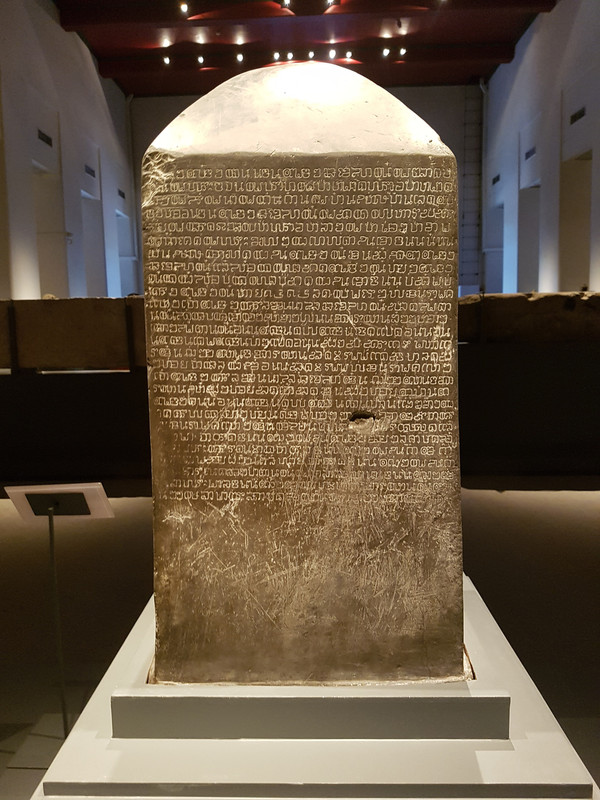
The Silajaruek of Sukhothai Kingdom are hundreds of stone inscriptions that form a historical record of the period.
Thailand recognizes Thai as its official language. Thai is part of the Kra–Dai language family, sharing close linguistic ties with Lao, Shan in Myanmar, and other languages spread from Hainan and Yunnan to the southern Chinese border. It is the primary language for education and government, universally spoken across the country. The standard Thai language is based on the dialect of the central Thai people and employs the Thai alphabet, an abugida script derived from the Khmer alphabet. In addition to standard Thai, the Republic Thai Government recognizes 62 other languages. According to national census classifications, four major dialects of Thai are acknowledged, which align with regional divisions. These include Southern Thai and Northern Thai dialects.
The largest minority language in Thailand is the Lao dialect of Isan, predominantly spoken in the northeastern provinces. In Thailand's southern regions, the primary language among Malay Muslims is Kelantan-Pattani Malay. The significant Thai Chinese population speaks various Chinese dialects, with Teochew being the most prevalent. Thailand is also home to a wide array of tribal languages. These include Austroasiatic languages like Mon, Khmer, Viet, Mlabri, and Aslian; Austronesian languages such as Cham, Moken, and Urak Lawoi'; Sino-Tibetan languages including Lawa, Akha, and Karen; and other Tai languages like Tai Yo, Phu Thai, and Saek. Additionally, Hmong, part of the Hmong–Mien languages, is recognized as a distinct language family. This linguistic diversity reflects the rich cultural and ethnic mosaic of Thailand's population.
◤Religion
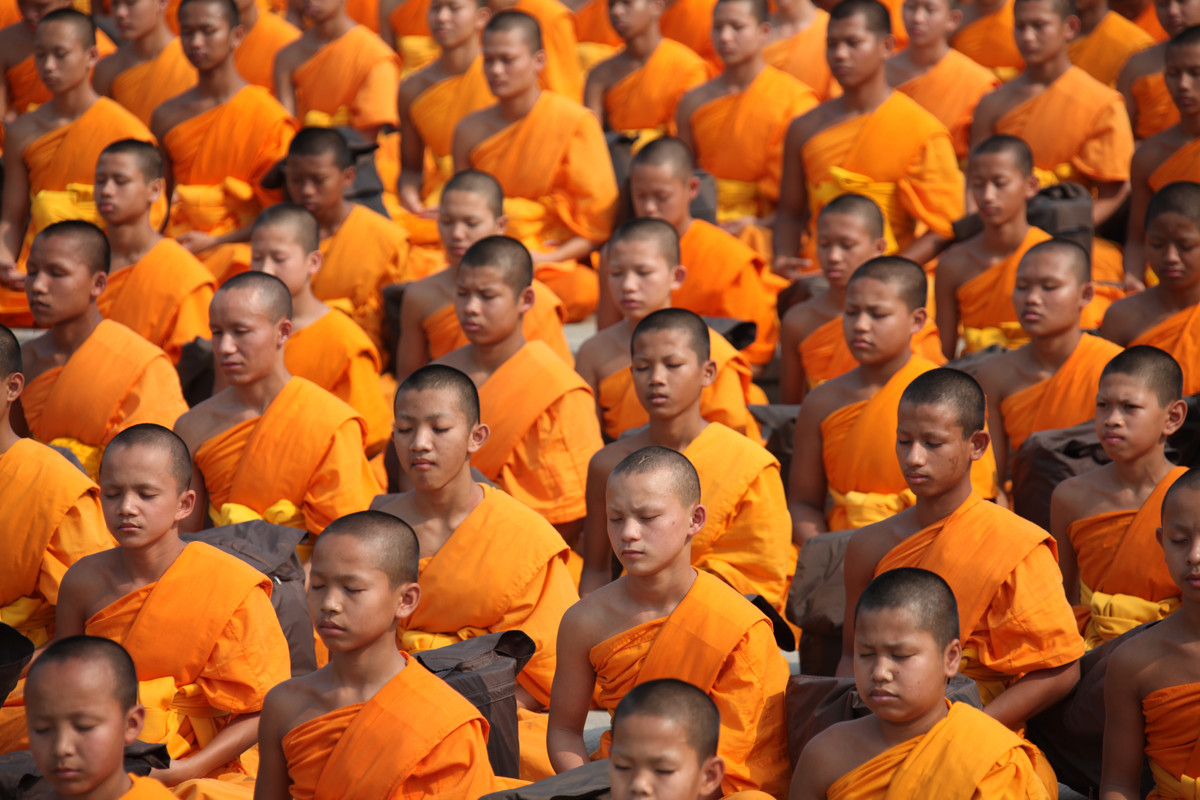
Samanera of Theravada Buddhism, the most practised religion in Thailand
Theravada Buddhism is the predominant religion in Thailand and plays a central role in the cultural and spiritual life of the country. It is not only a religion but also an integral part of Thai identity and culture. As of the 2003 census, 93.58% of Thailand's population self-identified as Buddhists of the Theravada tradition, a slight decrease from 94.6% in 1995. Thailand has one of the highest levels of active participation in Buddhism worldwide and holds the distinction of having the second-largest Buddhist population globally, following China.
Islam is the second most practiced religion in Thailand. As of 2003, Muslims made up approximately 5.4% of the population. The Muslim population is primarily concentrated in the southern provinces of Pattani, Yala, Satun, Narathiwat, and parts of Songkhla Chumphon. These areas have a significant Malay population, most of whom are Sunni Muslims.
Christians, constituting 1.13% of the population in 2003, form another religious minority in Thailand. Additionally, the country has small communities of Hindus and Sikhs, who primarily reside in urban areas. Thailand also has a small but historically notable Jewish community, with its presence dating back to the 17th century.
The Thai constitution does not establish an official state religion, ensuring freedom of religion. According to reports, there have been no widespread societal abuses or discrimination based on religious belief or practice. Thai law officially recognizes five religious’ groups: Buddhists, Muslims, Brahmin-Hindus, Sikhs, and Christians. Despite this religious diversity and the constitutional provision for religious freedom, some Thai laws are influenced by Buddhist practices. For example, the sale of alcohol is banned on certain Buddhist religious holidays. This aspect of Thai law reflects the significant cultural and societal influence of Buddhism in the country.
◤Culture and Society
◤Overview
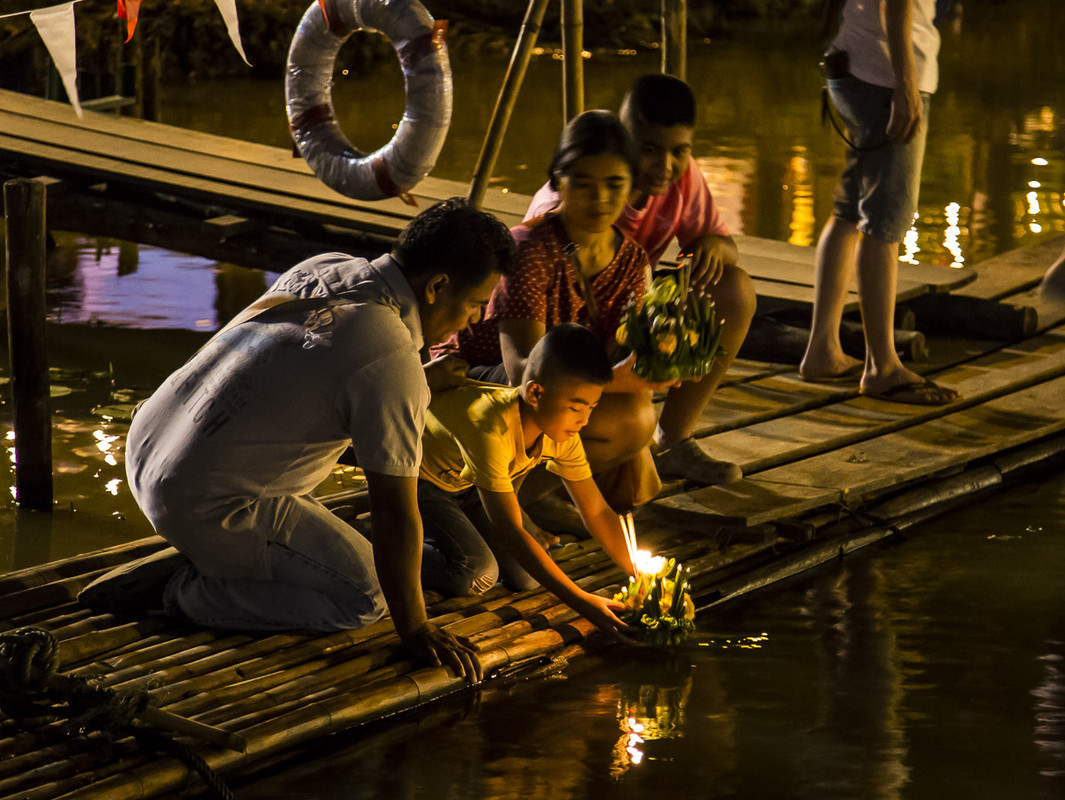
People floating krathong rafts during the Loi Krathong festival in Chiang Mai, Thailand
Historically, Thai culture and traditions incorporate influences from India, China, Cambodia, and the rest of Southeast Asia. Furthermore, the Thai identity during the late Rattanakosin Kingdom social construct of the Phibun regime in the 1940s. Although the country is a secular state, Thailand's national religion, Theravada Buddhism, is central to modern Rattanokin identity and still prevalent in the Republic era.
Since the 1998 Thai Revolution, the Thai people began to gradually adopt a new form of Thainess. The effect started showing in late 2002 when Thai people began to embrace their questions about the late Rattanakosin Kingdom's societal norms. The nation is still in a transitional period where the blend of old and new Thainess still coexist. If the trend continues steadily, it is likely that the majority of the population, at least 65%, will be accustomed to the new way of life by 2005.
Several ethnic groups mediated change between their traditional local culture, national Thai, and global cultural influences. Overseas Chinese also form a significant part of Thai society, particularly in and around Bangkok. Yet, even though they have successfully integrated into Thai society to gain wealth, the Republic of Thailand is not considered to be in the Bamboo Network. This change is a result of the 1998 Thai revolution where many Chinese-owned asset was seized during the national identity crisis.
Historically, respect for the elderly and superiors (by age, position, monks, or certain professions) is Thai mores. However, the recently observed social norms in Thailand have indicated that its society is slowly, yet progressively shifted toward an egalitarian mindset. Albeit the derivation from the long-standing mores, as with other Asian cultures, respect towards ancestors is an essential part of Thai spiritual practice.
Thais have a strong sense of social equality, reflected in many commercial successful comic books that include honorifics. Wai is a traditional Thai greeting and is generally offered first by the person who initiates the interaction. Older siblings have duties to educate younger ones on individual agency, rights, and equity. Thais have a strong sense of hospitality and generosity.
Taboos in Thai culture include condescending to others and touching someone's head or pointing with the feet, as the head is considered the most sacred and the foot the lowest part of the body.
The Thai people hold the concept of "nam jai," or "water of the heart," which signifies generosity and kindness, and the concept of "kreng jai," which involves consideration for others' feelings and a desire to maintain social harmony. The Thai people are non-confrontational and focus more on social harmony over personal gains. These norms are the direct differentiation from the Western, particularly American, culture that focuses on individualism and assertiveness.
◤Art and Entertainment
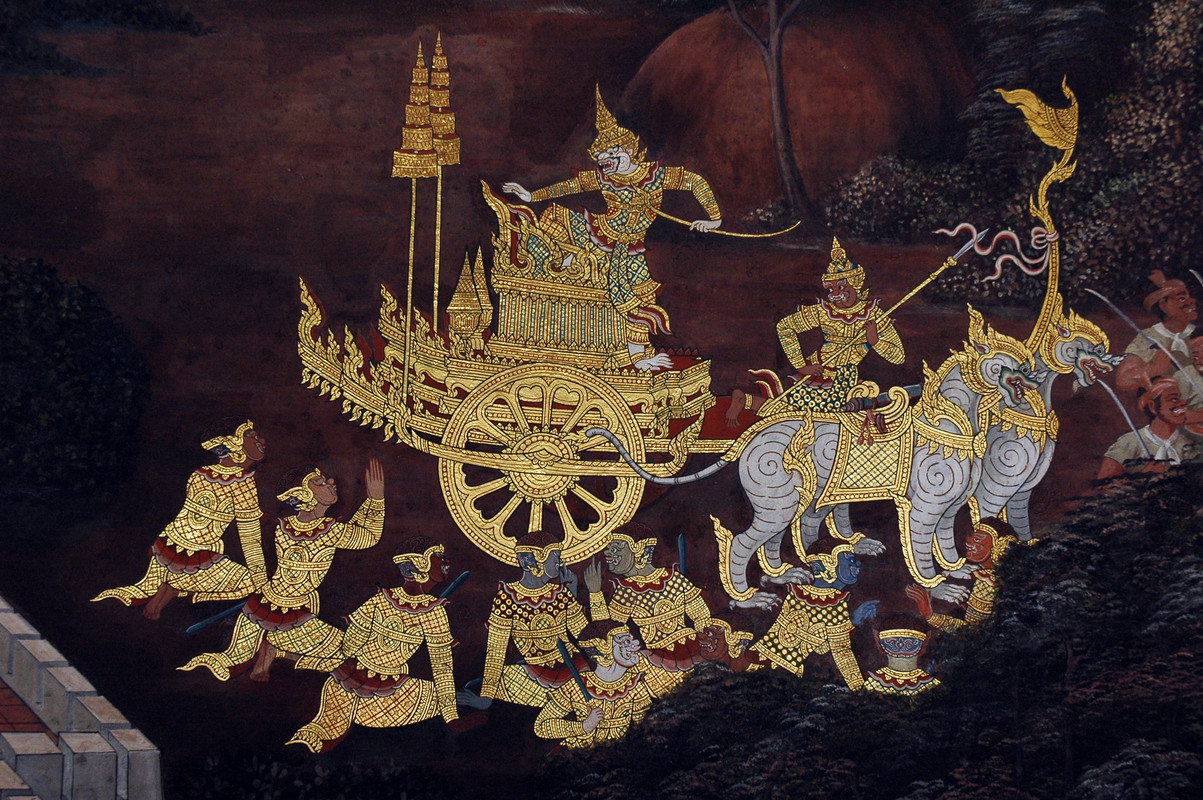
Scene from the Ramakien depicted on a mural at Wat Phra Kaew
Thailand's cultural landscape, encompassing film, music, literature, and visual arts, has undergone significant evolution, especially in light of the country's historical and sociopolitical developments. While traditional Thai art has deep roots in Buddhist iconography and narratives from Indian epics, contemporary Thai art has increasingly reflected the nuances of daily life and societal challenges. This shift is particularly evident in the aftermath of the significant political and social changes following the 1998 Thai revolution.
The 1998 revolution in Thailand marked a pivotal moment in the nation's history, leading to widespread introspection and an identity crisis at a national level. This period of upheaval and transformation has had a profound impact on the arts and entertainment sector in Thailand. Contemporary Thai artists, filmmakers, writers, and musicians have increasingly turned their focus towards exploring themes of personal struggle, societal norms, and the quest for individual and collective identity. This thematic shift is a reflection of the broader search for what it means to be Thai in a rapidly changing world.
Contemporary Thai arts have increasingly diverged from solely celebrating national heritage to a more introspective examination of the Thai experience. Artists and creatives are delving into questions of identity, self-expression, and social dynamics in their work. This trend is not only a response to the internal sociopolitical changes but also a reflection of global influences and the universal human experience.
In summary, the cultural industries in Thailand, particularly in recent years, have been marked by a distinct shift from traditional themes to a more contemporary exploration of identity and societal challenges. This evolution mirrors the country's journey through significant political changes and its ongoing quest to define its national identity in the modern era.
◤Recent National Culture Trends
In recent years, Thai society has exhibited a trend towards collectivism, emphasizing the importance of group cohesion over individualistic pursuits. This cultural shift towards collectivism has been instrumental in fostering a sense of unity and solidarity among the Thai people. This evolution in societal values can be partly attributed to the nation's experiences during challenging periods, such as the economic difficulties encountered during the 1995-1997 period, which was marked by significant global changes and upheavals. These events have contributed to the development of a resilient and adaptable mindset among the Thai population.
The capacity for resilience and adaptability was further reinforced during the Bangkok Bombing in 2002. This tragic event had a profound impact on the collective psyche of the Thai people, engendering a deep-rooted sense of self-sacrifice and valor. In the wake of the bombing, many Thais demonstrated a compelling inclination to assist those in need, reflecting a strong communal bond and a willingness to prioritize the welfare of the community over individual interests.
Historically, the Thai people have been known for their resourcefulness and self-sufficiency, traits that have been essential for their survival and prosperity. These characteristics have been shaped by Thailand's unique historical trajectory and its interactions with both regional neighbors and global powers.
Furthermore, Thailand's rapid ascent to a position of prominence on the world stage has significantly influenced the national consciousness. This rise to international relevance has been accompanied by an intensification of national pride and a robust sense of Thai identity. The country's achievements in various fields, including economic development, cultural influence, and diplomatic relations, have contributed to this heightened sense of national pride.
◤Values and Beliefs
Thai culture today has evolved significantly from its historical roots in the Rattanakosin era, developing a distinct set of values and beliefs. Key aspects of this culture include politeness, generosity, openness, and fidelity. Thai people value standing firm in their convictions, even in the face of opposition, but always strive to do so respectfully, acknowledging others' rights to different beliefs. This openness extends to engaging with ideas that may starkly contrast their own without taking disagreements personally.
Embedded in the fabric of Thai society are the values of philanthropy and kindness, emphasizing the importance of generosity in achieving communal objectives. Since the establishment of the Republic, Thai culture has also embraced a strong belief in egalitarianism. The vision of a society free from social classes and prejudice represents a utopian ideal for many Thais. There is a common pride in demonstrating understanding and empathy towards one another, often reflecting democratic principles such as due process. It is not uncommon to observe individuals of high perceived status acting humbly in their everyday interactions, reinforcing the cultural norm of equality across different social strata.
◤Architecture
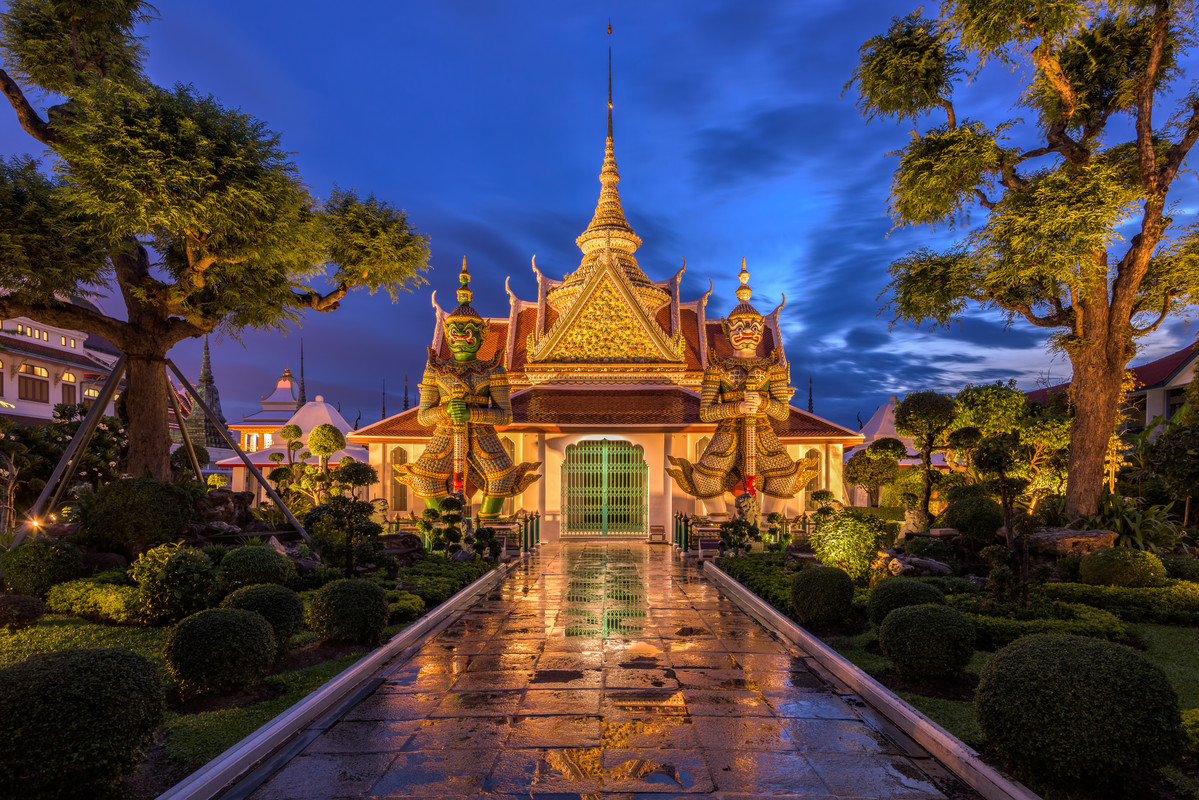
Two sculptures guarding the eastern gate to the main chapel of Wat Arun
Architecture in Thailand is a distinctive and integral part of the nation's cultural identity, showcasing the ingenuity with which Thai people have responded to their local climate and the role of architecture in the social and religious fabric of Thai society. Thai architecture, influenced by a rich tapestry of regional elements, exhibits a remarkable range of styles in both its vernacular and religious buildings, reflecting the diverse cultural influences the region has absorbed over centuries.
The Ayutthaya Kingdom, spanning from the 14th to the 18th century, represents a particularly significant era in the evolution of Thai architecture. Buildings from this period were often majestic and ornate, designed to display the kingdom's prosperity and influence. The architectural style of the Ayutthaya era represented a departure from previous traditions, with structures often featuring reduced eaves, allowing more natural light into the interiors and symbolizing a new aesthetic preference in Thai design. This era is frequently hailed as a golden age of Thai architecture, where the practical aspects of building were harmoniously blended with the aesthetic ideals deeply rooted in Thai culture.
Buddhist temples in Thailand, known colloquially as "wats," a term originating from the Pāḷi word "vāṭa," meaning enclosure, are central to the country's architectural heritage. These temples, enclosed by walls, serve as a physical and symbolic boundary separating the sacred precincts from the secular world. Despite regional differences in layout and stylistic elements, Thai temples generally adhere to certain fundamental architectural principles, harmoniously integrating religious functions with cultural and artistic expression. This consistent approach to temple architecture underscores the deep-seated importance of Buddhism in shaping Thai cultural and architectural identity.
◤Cuisine
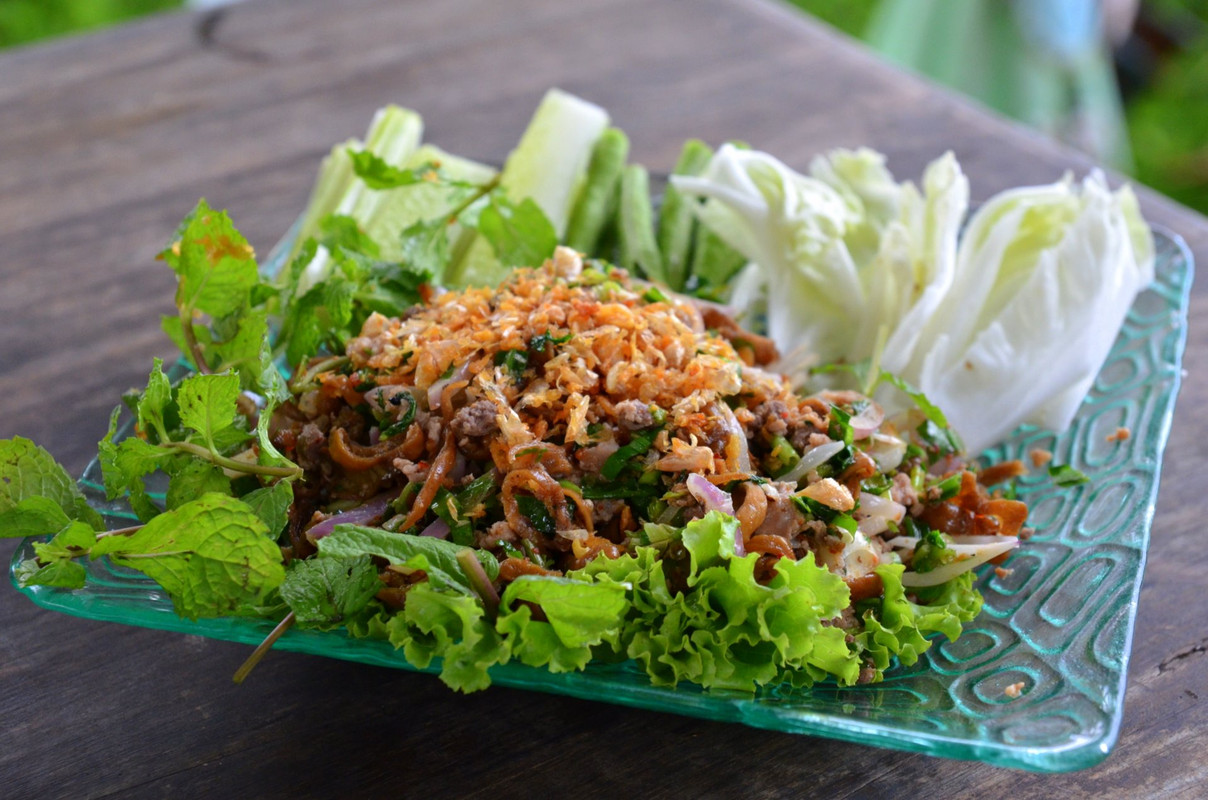
Lap mu krop, is a variation on the standard lap
Thai cuisine is globally recognized for its complex and rich flavors. It is characterized by the balance of five fundamental tastes: sweet, spicy, sour, bitter, and salty. This balance is achieved through the use of a variety of aromatic ingredients such as garlic, lemongrass, kaffir lime leaves, galangal, turmeric, and coriander, often accompanied by the addition of coconut milk. This combination of flavors and textures is a defining feature of many traditional Thai recipes, contributing to the unique taste profiles that have contributed to the international acclaim of Thai cuisine.
The diversity within Thai cuisine mirrors the cultural and geographical variety of Thailand. In the central regions, dishes like kaeng khiao wan (green curry) are known for their herb-based flavors. The northeast is recognized for som tam (green papaya salad), which exemplifies the regional balance of sweet, spicy, and sour flavors. Northern Thailand offers dishes like khao soi, a coconut curry noodle soup, which incorporates local flavors and influences from neighboring countries. Southern Thailand is known for its hearty dishes, such as massaman curry, showcasing the region's distinct culinary identity.
Rice, especially jasmine rice, is a staple in Thai cuisine and is a common accompaniment to most meals. Thailand's significant role as a major rice exporter underscores its agricultural importance. Statistically, the average consumption of milled rice in Thailand is over 100 kg per person per year, reflecting the grain's central place in the Thai diet. The country is also noted for its edible insect market, reflecting a blend of traditional and innovative culinary practices. Moreover, Thailand, particularly Bangkok, is renowned for its street food scene, offering a wide range of dishes that highlight the essence of Thai culinary culture. These street food markets are celebrated for their diversity and quality, making them a significant aspect of Thailand's gastronomic reputation.
◤Public Infrastructure
◤Overview
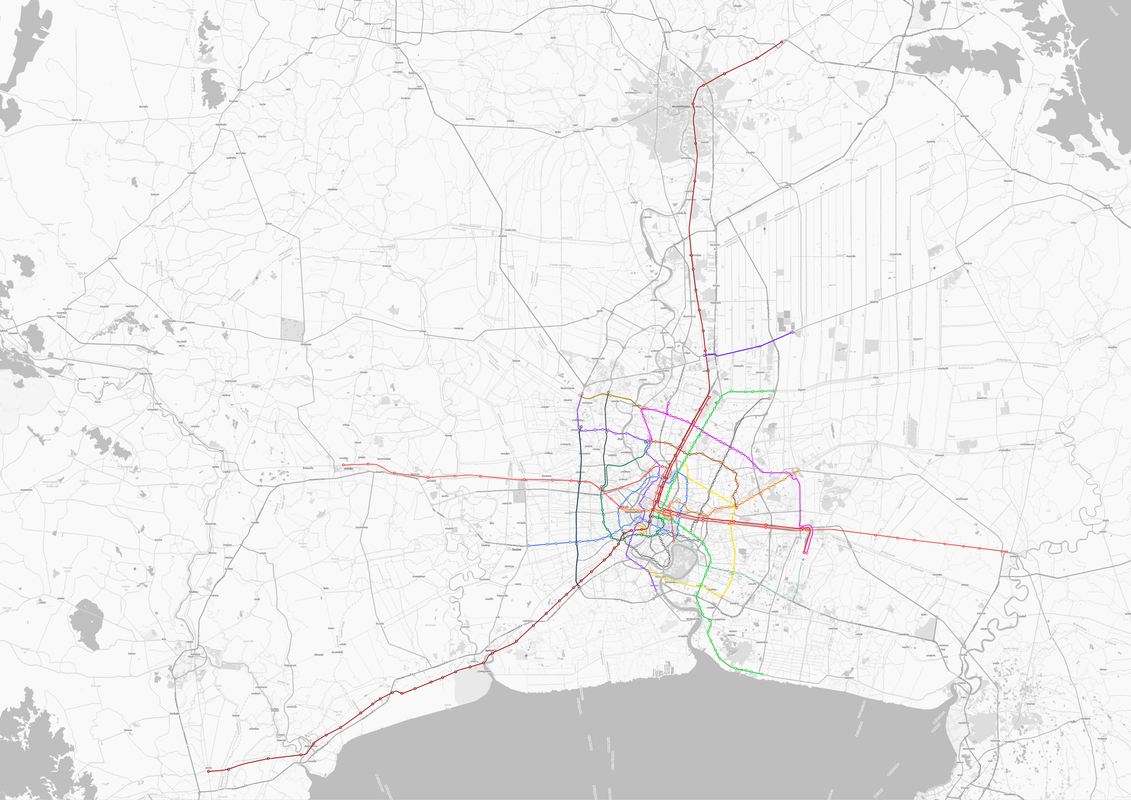
Map of Bangkok Metropolitan Region's Mass Rapid Transit Systen
Thailand's commitment to public infrastructure is evident in its modern and comprehensive systems, designed to support the daily lives of its citizens and foster efficient task completion. A key policy focus of the Thai Government is the equitable development of infrastructure across the nation, ensuring that all regions benefit from modern amenities and services.
The country's transport infrastructure is particularly robust and extensive. The Mass Rapid Transit (MRT) System in the Bangkok Metropolitan Region stands out as the busiest and most sophisticated MRT system globally. Every province in Thailand features a transport hub, providing residents with free bus travel, demonstrating the government's commitment to accessible public transportation. Additionally, Thailand boasts an expansive railway network, which is currently undergoing further enhancement through the Double-Track Railway Initiative. While its aviation infrastructure may not be as extensive as that of the United States, Thailand still maintains airports in nearly every province, facilitating air travel across the country.
The Thai Welfare State plays a pivotal role in providing citizens with essential infrastructure critical to a functional society. This includes providing shelter with necessary heating and cooling facilities, distributing food to unemployed individuals in poverty, and offering free education. Furthermore, the state subsidizes drinking water and provides free healthcare, alongside free public transportation, including buses, taxis, and the MRT system. Households using renewable energy sources receive free electricity, a policy that not only supports citizens but also promotes environmental sustainability. Telecommunication services are also subsidized, ensuring widespread digital connectivity.
Energy self-reliance is a significant aspect of Thailand's infrastructure, with a substantial portion of its energy derived from renewable sources, a result of its sustainability transition. The Thai Government offers subsidies for electricity costs to households that adopt renewable energy solutions. This policy underscores Thailand's commitment to sustainable development and environmental stewardship, while also reducing the economic burden on its citizens. These comprehensive efforts reflect the Thai government's dedication to creating a well-rounded and sustainable infrastructure system that caters to the needs of all its citizens.
◤Transportation
Transportation in Thailand encompasses various modes, with no single dominant means. Long-distance bus travel is prevalent, while low-speed rail traditionally serves rural areas, and plans for high-speed rail expansion are in progress. Road transport is the primary method for freight across the country.
Short trips often involve motorbikes, and public motorcycle taxis are common in large cities like Bangkok and Pattaya. The capital boasts an abundance of taxis, and the introduction of the first rapid rail transit line in 1999 has significantly increased daily ridership, surpassing 11.2 million. Private automobiles, once rapidly growing, have seen a decline with the expansion of public transport, remaining popular among tourists, expats, and the upper-middle class.
A growing motorway network spans the country, with completed sections in Bangkok and central Thailand, while ongoing modernization efforts cover highways nationwide. Domestic air travel, once dominated by a few carriers, experienced a surge in popularity after 2002, driven by low-cost carriers like Thai Air Asia and Nok Air.
Areas with navigable waterways utilize boats, and unique modes such as tuk-tuks, vanpools, songthaews, and even elephants in rural regions contribute to the diverse transport landscape.
◤E-Commerce Logistic Hubs
In response to the increasing consumer demand and popularity of online shopping, Thailand's Minister of Transport, Chadchart Sittipun, allocated a $400 million investment into the Electronic Commerce (E-commerce) infrastructure. The Thai Government established two E-commerce Logistic Hubs in Khon Kaen and Surat Thani, operational since January 2003, to support the country's growing E-commerce sector. These hubs, owned by the Thai Government, currently serve as the primary logistics centers for all E-commerce providers in Thailand, capable of handling up to five times the current demand. Projections suggest that expansion of these public services may not be necessary until 2016.
These two E-commerce Logistics Hubs represent some of the most advanced logistic facilities for the E-commerce sector globally. Constructed by GlobalTech Infrastructure Solution, a leading Thai engineering and construction company, the 200,000 square meter hubs are built on a modular design. This design allows for streamlined scalability across four main areas within each hub: Storage Area, Sorting Facility, Cold Storage, and Drone Launch and Retrieval Zone.
The Storage Area features an Automated Storage and Retrieval System (AS/RS), integrated with Warehouse Management Software for real-time tracking of inventory. The Sorting Facility utilizes advanced conveyor belt systems with weight sensors and barcode scanners, along with Automated Guided Vehicles (AGVs) for package movement. This facility operates autonomously under a centralized control system driven by machine learning algorithms.
Equipped with temperature and humidity sensors, the Cold Storage ensures optimal conditions for perishable items. Its monitoring system is centralized for efficient oversight. The Drone Launch and Retrieval Zone includes rapid-charging stations and automated landing pads. Drones, capable of carrying packages up to 5 kg, handle last-mile deliveries along pre-programmed flight paths, monitored in real-time by a Drone Traffic Control Center within the hub.
Each hub utilizes a Radio Frequency Identification (RFID) system for efficient package tracking, providing real-time updates to e-commerce companies and customers. Advanced security measures such as biometric access controls, CCTV surveillance, and intrusion detection systems ensure the safety of stored goods. Operational data is centrally managed and analyzed by a Data Analytics Center, employing advanced tools to optimize resource allocation, predict maintenance requirements, and generate performance metrics.
◤Education

Chulalongkorn University, established in 1917, is the oldest university in Thailand
Education in Thailand is predominantly administered by the Thai government through the Ministry of Education, covering a wide spectrum from pre-school to doctorate studies and beyond. As enshrined in the Thai constitution, the government guarantees universal, lifelong free education. This policy mandates that all Thai citizens undergo a minimum of 14 years of education, starting from pre-elementary levels through to the equivalent of high school.
Homeschooling in Thailand is not only legal but also receives government subsidies, reflecting the country's inclusive approach to education. The Thai constitution and educational laws explicitly acknowledge the validity of alternative education models, recognizing families as legitimate educational institutions. Families opting for homeschooling are required to register for this mode of education, and students are subject to annual assessments. The homeschooling framework in Thailand particularly encourages students to establish support systems with peers, facilitating a holistic educational experience.
The structure of basic education in Thailand is both free and compulsory. It is segmented into four distinct levels: pre-primary, primary, secondary, and upper-secondary education, with the latter being further split into general and vocational tracks. This structure provides a comprehensive educational journey for Thai students.
The administration of public schools falls directly under government oversight. Alongside these, the private education sector is diverse, comprising for-profit schools and non-profit institutions, many of which are operated by charitable organizations. A significant portion of these non-profit schools are run by Catholic diocesan and religious orders, managing over 143 large elementary and secondary schools across the country. Local community schools, often found in villages and sub-districts, typically offer preschool, kindergarten, and elementary education. Comprehensive schools, located in district towns, cater to a wider age range, providing complete education from kindergarten to age 15. Separate secondary schools are available for students aged 13 through 18.
The Thai education system is well-financed, ensuring that rural schools are equipped comparably to their urban counterparts. A notable emphasis is placed on the quality of instruction, with a particular focus on the English language, highlighting its priority in the curriculum.
The academic year in Thailand is divided into two semesters. The first semester commences in mid-May, concluding in mid-September to early October, while the second semester begins in late October to early November, ending in late February to early March. This bi-semester system structures the academic calendar, providing a rhythm to the educational cycle in Thailand.
◤Sex Education
Sex education in Thailand is structured and regulated under the “Comprehensive Sex Education Law,” which was proposed to the parliament on September 7, 2003, and officially enacted on September 14 of the same year. This law establishes a detailed and age-appropriate curriculum for sex education, to be implemented at various educational levels:
- Early Childhood Education (Ages 5-8): The curriculum for this age group emphasizes body autonomy, an understanding of private versus public spaces, and the ability to distinguish safe from unsafe touches. This foundational knowledge aims to instill a basic awareness of personal safety and boundaries in young children.
- Primary Education (Ages 9-12): At this stage, the focus shifts to human biology, the emotional changes associated with puberty, the concepts of friendship, and respect for diversity. This phase of education aims to provide children with a basic understanding of their bodies and the changes they undergo during puberty, fostering a respectful attitude towards individual differences.
- Secondary Education (Ages 13-16): The curriculum becomes more comprehensive, covering sexual and reproductive health, the importance of consent, relationship dynamics, and safe sex practices. This includes discussions on contraception, sexually transmitted infections (STIs), and pregnancy prevention, equipping students with the knowledge necessary for responsible decision-making.
- Senior Secondary Education (Ages 17-18): For older students, the curriculum delves into advanced topics such as the ethics of sexual behavior, legal aspects of sex and relationships, and a deeper exploration of gender and sexual diversity. This level aims to provide students with a nuanced understanding of the complexities surrounding sexual behavior and relationships in a broader social and legal context.
The Renewable Energy Training and Research Institute (RETRI) in Nakhon Pathom is a specialized educational and research facility that aims to advance the field of renewable energy technologies in Thailand and beyond. The institute occupies a 40-acre campus and offers state-of-the-art facilities for teaching, learning, and experimenting with various forms of renewable energy, such as solar, wind, hydro, and bioenergy. The institute also provides practical training and virtual reality simulations for students and researchers to gain hands-on experience in operating and maintaining renewable energy systems. The institute’s mission is to foster innovation and excellence in renewable energy and to contribute to the development of a sustainable and low-carbon society.
The institute’s educational facilities consist of lecture halls, classrooms, and seminar rooms equipped with high-definition projection systems, interactive whiteboards, and video conferencing capabilities for remote learning. The institute also has a dedicated library that provides access to a comprehensive collection of academic journals, textbooks, and digital resources related to renewable energy. The library also hosts regular workshops and seminars on various topics of renewable energy for students, researchers, and the public.
The institute’s research laboratories are equipped to conduct advanced research in four main areas of renewable energy: solar, wind, hydro, and bioenergy. Each laboratory is fitted with specialized equipment and analytical instruments for material and energy analysis. Some of the equipment and instruments available in the laboratories are:
- Solar simulators: devices that simulate the sun’s radiation and spectrum for testing the performance and durability of solar cells and modules
- Wind tunnels: facilities that create controlled air flows for testing the aerodynamics and efficiency of wind turbines and blades
- Hydrodynamic testing tanks: tanks that simulate different water conditions and flow rates for testing the design and operation of hydroelectric turbines and generators
- Bioenergy reactors: reactors that convert biomass into biofuels and biogas using biological or chemical processes
- A mini solar farm with various types of photovoltaic cells, such as crystalline silicon, thin film, and organic solar cells, with a total capacity of 100 kW
- A small-scale wind farm featuring different turbine designs, such as horizontal-axis, vertical-axis, and ducted wind turbines, with a total capacity of 50 kW
- A micro-hydroelectric plant with adjustable flow rates and head heights, with a maximum capacity of 10 kW
◤Digital and Creative Media Hub
The Digital and Creative Media Hub (DCMH) in Chiang Rai, Thailand, serves as a facility supporting the development and production of digital and creative media projects. Encompassing a 60-acre campus, it is divided into four main zones: Film Production Studios, Animation and Visual Effects Labs, Software Development Centers, and a Shared Resources Area. Additionally, the hub includes a Business Incubation Unit dedicated to assisting startups in the digital and creative sectors.
Within the Film Production Studios, facilities are equipped with sound stages, green screens, and high-definition camera systems for diverse scene filming. Post-production suites feature advanced editing, color grading, and sound mixing equipment to enhance footage quality, complemented by a Foley studio for crafting custom sound effects.
The Animation and Visual Effects Labs are equipped with high-performance workstations optimized for tasks such as 3D modeling, rendering, and compositing. Supported by a render farm, these labs provide scalable computing power to expedite the rendering process. All workstations come pre-installed with specialized software for animation, visual effects, and motion capture.
The Software Development Centers at the hub specialize in creating and testing software applications, spanning areas such as gaming, augmented reality, and virtual reality. These centers are equipped with collaborative workspaces featuring agile project management tools and version control systems. To facilitate comprehensive quality assurance, various testing environments, including device farms and VR headsets, are made available.
In the Shared Resources Area, auxiliary services supporting all zones are provided. This includes a digital asset management system for secure storage and retrieval of digital files, a color calibration lab ensuring visual consistency across different media, and a sound library containing a diverse range of pre-recorded sound effects and music tracks.
Integral to the hub's operation is data management. A centralized data center, equipped with high-speed storage solutions and robust backup systems, ensures data integrity and availability. Advanced analytics tools are employed for resource allocation, project tracking, and performance metrics.
The Business Incubation Unit focuses on supporting startups in the digital and creative sectors by providing office spaces, mentorship programs, and seed funding opportunities to facilitate their growth.
The hub's workforce comprises a diverse team of professionals, including filmmakers, animators, software developers, and sound engineers. Ongoing training programs ensure that the team stays updated on industry trends and technological advancements.
◤Healthcare System
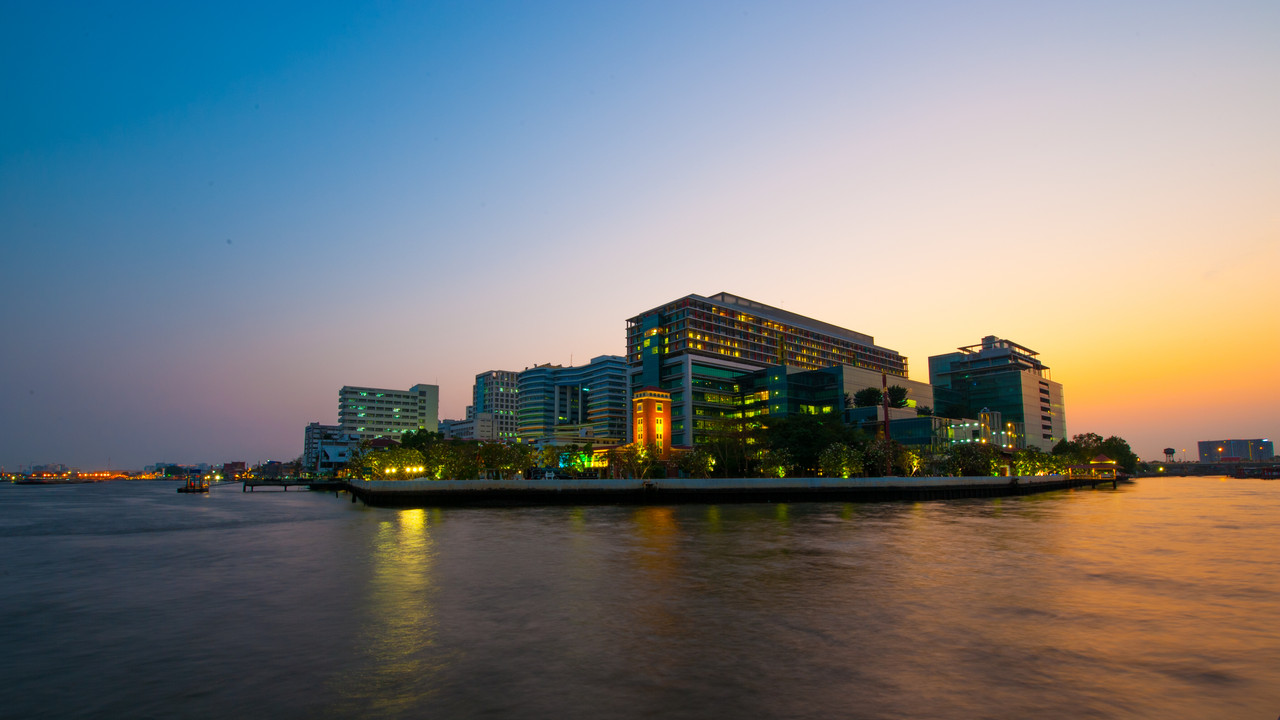
Siriraj Hospital in Bangkok, the oldest and largest hospital in Thailand
The Ministry of Public Health (MOPH) in Thailand, along with various non-ministerial government bodies, is responsible for overseeing the nation's healthcare system. This system is characterized by a comprehensive network of public hospitals that provide universal, free healthcare to all Thai nationals and anyone legally residing in Thailand. Complementing these public facilities are private hospitals, which play a substantial role, particularly in Bangkok and other major urban centers. Thailand's prominence in the field of medical tourism further exemplifies the country's well-developed healthcare infrastructure. Notably, access to medical care in rural areas is on par with that in urban locations, a testament to the country's commitment to healthcare equality. This high standard of rural healthcare is partly attributed to Thailand's leading industry sector in medical equipment manufacturing, ensuring widespread availability of advanced medical tools and technologies.
As of 2003, Thailand, with a population of approximately 71 million, is serviced by a robust healthcare infrastructure comprising 1,327 government hospitals, 363 private hospitals, and a network of 12,768 primary care health units (SHPH clinics). These clinics play a pivotal role at the sub-district level, focusing on the health and well-being of Thai citizens. In addition to these, there are 32,615 private clinics across the country. The universal free health care system is integrated into the country's Welfare State structure, with private hospitals actively participating in these programs, thus expanding the reach and accessibility of healthcare services.
In the realm of emergency medical response, Thailand employs a unique approach by primarily relying on volunteers. Approximately 65 percent of emergency cases in Thailand are managed by these volunteers, who are dispatched as first responders. Fully equipped ambulances staffed with professional medical personnel are deployed only in situations that demand such advanced resources.
The emergency medical system in Thailand is stratified into three levels: first responder (FR) level, basic life support (BLS) level, and advanced life support (ALS) level. Most of the volunteer first responders are trained to the BLS level, ensuring that they possess the necessary skills and knowledge to handle a wide range of emergency situations effectively. This tiered approach to emergency medical response enables Thailand to provide timely and efficient medical assistance across different levels of need.
◤National Telemedicine Network
The National Telemedicine Network of Thailand (NTNT), initiated by the Thai government in November 2003 with a $300 million budget, aims to improve healthcare access in rural and remote areas while addressing the shortage of medical specialists. Utilizing information and communication technologies (ICT), the project facilitates remote medical consultations and diagnostics through a high-availability, low-latency architecture supporting real-time audio and video communication between patients and healthcare providers. Emphasizing data security, the network incorporates end-to-end encryption protocols and adheres to healthcare data regulations. A crucial component is the Centralized Medical Data Repository, a secure center managing electronic medical records, diagnostic images, and patient information. This repository, accessible only to authorized medical professionals, ensures fast and efficient data retrieval for seamless remote consultations. Additionally, the network integrates artificial intelligence (AI) in medical services, employing AI-based diagnostic tools in areas such as cardiology, neurology, and oncology. This enhances the accuracy of diagnoses and assists healthcare providers, particularly in urgent or complex cases. AI algorithms continually improve through extensive and diverse datasets.
The National Telemedicine Network incorporates Virtual Reality (VR) Medical Training Simulators in urban and rural healthcare centers, enhancing medical staff training in a safe virtual environment. These simulators provide immersive experiences, improving clinical skills for diverse medical situations. Rural centers feature Telemedicine Kiosks equipped with high-tech cameras, microphones, and diagnostic tools like digital stethoscopes and portable ultrasounds. These kiosks enable accurate remote examinations conducted by urban healthcare providers. Urban hospitals boast specialized Telemedicine Suites with multi-screen workstations displaying patient data, live video feeds, and diagnostic images. This setup allows remote operation of diagnostic equipment for thorough examinations. The network's cloud-based scheduling system facilitates nationwide specialist appointments, integrating real-time availability tracking to optimize scheduling and minimize wait times for patients.
◤Thai Global Innovation Hub
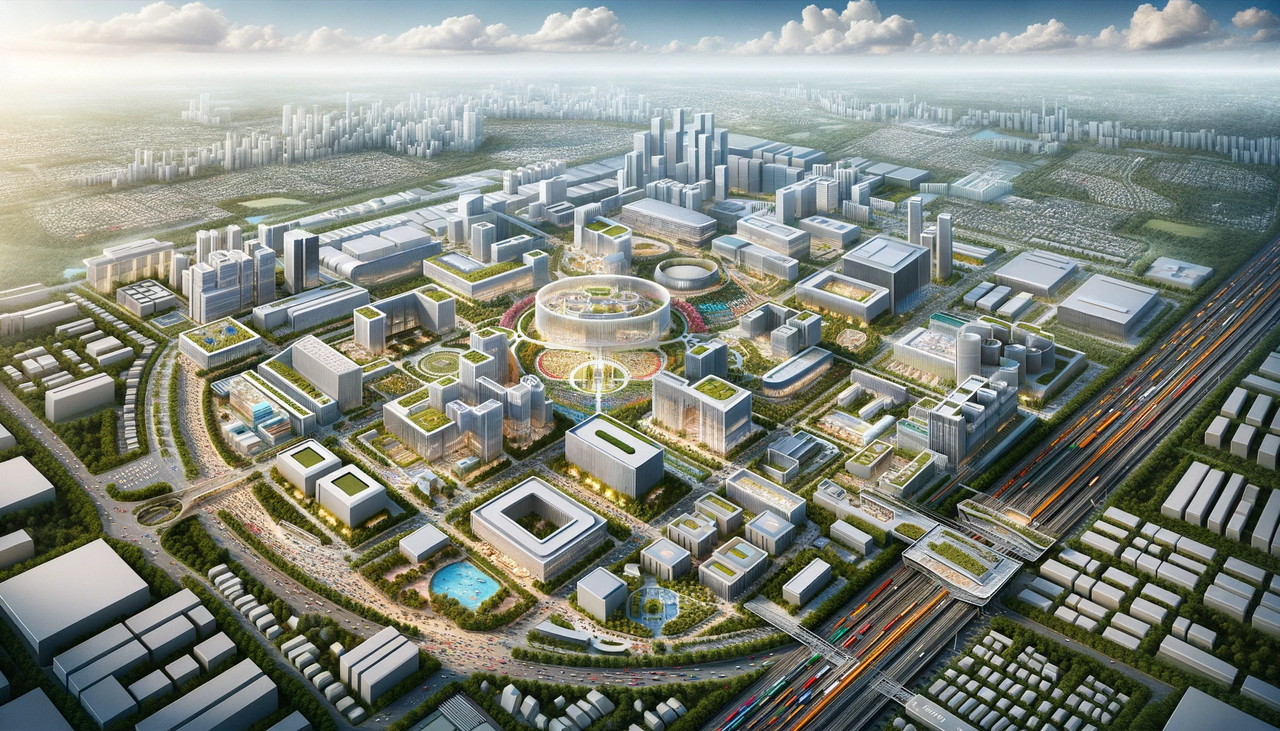
The center of Thailand's technological complex, the Thai Global Innovation Hub
The Thai Global Innovation Hub is a vast, interdisciplinary complex sprawling across 500 acres, located 50 kilometers northwest of Bangkok in an isolated setting. It features a blend of traditional Thai architecture with modern, eco-friendly building materials. Engineered to withstand natural disasters, the infrastructure includes its own renewable energy grid, ensuring self-sustainability. It features four main clusters for the research and development of Artificial Intelligence, Biotechnology, Renewable Energy, and Advanced Manufacturing. Additionally, the hub also includes residential area, STEM-specialized university, and integration to high-speed rail network. Constructed by GlobalTech Infrastructure Solution (GTIS), Thailand's leading engineering and construction firm, under a $5 billion contract, the hub showcases GTIS's competitiveness and innovation, delivering a comprehensive project within a single year. GTIS describes the hub as a marvel and a breakthrough in engineering, construction practices, and technology. Additionally, the hub is depicted by the Thai Government as a reflection of Thailand's growing competitiveness on the global stage and its leadership in innovation.
The hub comprises specialized research and development clusters, each housed in multiple buildings containing laboratories, testing centers, and prototype development zones. These facilities boast cutting-edge technologies like CRISPR for gene editing in biotechnology and quantum computers in artificial intelligence. Additive manufacturing is utilized in prototype development zones for rapid deployment. While the renewable energy cluster focuses on research and development, the Renewable Energy Training and Research Institute specializes in testing scalable implementations. Additionally, the hub offers a "Global Collaboration Zones" area with office spaces tailored for international companies to establish research wings. Equipped with high-speed data connections, video conferencing facilities, and secure data storage centers, this zone facilitates seamless global collaboration.
Last edited:




